#land of creation b
Text
Personal Branding with Unbounce: Building Your Page
Understanding Unbounce: Empowering Personal Branding through Intuitive Page Building
In the dynamic landscape of digital marketing, creating an impactful online presence is paramount for personal branding. Among the myriad tools available, Unbounce stands out as a versatile platform designed to streamline the process of building engaging and conversion-focused web pages. In this post, we'll delve into the essence of Unbounce, exploring its key features and how it facilitates page building for effective personal branding.
A. Brief Introduction to Unbounce
Unbounce, founded in 2009, has evolved into a go-to solution for individuals and businesses looking to create landing pages and websites without the need for coding expertise. The platform's user-friendly interface empowers users to design, publish, and test pages for optimal conversion rates. At its core, Unbounce is a drag-and-drop builder that democratises web design, making it accessible to anyone with a vision for their personal brand.
B. Features and Capabilities
Drag-and-Drop Builder: Unbounce's intuitive drag-and-drop builder eliminates the technical barriers associated with web design. Users can effortlessly place elements, customize styles, and arrange content without writing a single line of code.
Template Library: To cater to diverse branding needs, Unbounce offers a rich library of templates. From minimalist designs to bold and vibrant layouts, users can choose a template that resonates with their personal brand identity and tweak it to perfection.
Mobile Responsiveness: In an era where mobile browsing is ubiquitous, Unbounce ensures that your pages look impeccable on any device. The platform's responsive design capabilities enable seamless viewing across smartphones, tablets, and desktops.
A/B Testing: Understanding what resonates with your audience is crucial for personal branding success. Unbounce facilitates A/B testing, allowing users to experiment with different page elements and layouts to identify the most effective variations.
Integration with Marketing Tools: Unbounce seamlessly integrates with popular marketing tools, such as email marketing platforms and customer relationship management (CRM) systems. This ensures a cohesive marketing ecosystem for personal brand management.
C. How Unbounce Facilitates Page Building for Personal Branding
Building a personal brand requires a digital space that reflects one's identity, values, and offerings. Unbounce, through its user-centric design and robust features, becomes a catalyst for effective personal branding.
Expressive Visual Design: Unbounce's drag-and-drop builder enables users to translate their personal brand aesthetics into a visually stunning web page. Whether you're a creative professional or a business consultant, the platform provides the canvas for your unique narrative.
Optimized Conversion Paths: Personal branding is not just about making an impression; it's about converting visitors into followers or clients. Unbounce's A/B testing and analytics tools empower users to refine their pages continuously, ensuring that the user journey aligns with personal branding goals.
Time and Cost Efficiency: Traditional web development can be time-consuming and expensive. Unbounce accelerates the process, allowing individuals to quickly bring their personal brand to the digital forefront without breaking the bank.
In conclusion, Unbounce emerges as a dynamic ally for individuals seeking to establish and enhance their personal brand online. By combining simplicity with powerful features, it empowers users to shape their digital identity with ease, fostering a connection with their audience that goes beyond the pixels on the screen. As the digital landscape continues to evolve, Unbounce remains a reliable companion for those on the journey of personal branding, providing the tools needed to stand out in the crowded online space.
III. Setting the Foundation: Crafting a Powerful Personal Branding Page
In the dynamic landscape of the digital age, individuals are increasingly recognizing the importance of establishing a strong personal brand. Whether you are a professional, entrepreneur, or creative, your online presence can significantly impact your success. To navigate this space effectively, setting a solid foundation is paramount. This involves defining your personal brand, establishing clear goals, and leveraging tools like Unbounce to create an impactful personal branding page.
A. Defining Your Personal Brand
Identifying Core Values:
At the heart of any successful personal brand lies a clear understanding of your core values. These values are the guiding principles that shape your identity and influence how others perceive you. Take the time to introspect and identify the values that resonate with you on a profound level. Whether it's innovation, integrity, or collaboration, aligning your personal brand with your core values ensures authenticity and sincerity.
Understanding Target Audience:
To resonate with your audience, it's crucial to understand who they are. Analyze the demographics, interests, and needs of your target audience. This insight will inform the tone, content, and visual elements of your personal branding page. Tailoring your message to address the specific concerns and aspirations of your audience establishes a deeper connection and fosters trust.
B. Establishing Clear Goals for Your Personal Branding Page
With your core values and target audience in mind, set clear and achievable goals for your personal branding page. Define what success looks like for you – whether it's increasing visibility, building a community, or showcasing your expertise. Your goals will serve as the foundation for the content and design choices you make on your personal branding page. They provide direction and purpose, guiding visitors towards the actions you want them to take.
C. Selecting a Template on Unbounce
Unbounce, a powerful landing page builder, can be a game-changer in bringing your personal brand to life. Begin by exploring the diverse range of templates Unbounce offers. Choose a template that aligns with your brand aesthetic and complements your content goals. The template serves as the canvas on which you'll craft your narrative, so ensure it reflects the professional image you want to portray.
Customizing your chosen template involves incorporating your brand colors, logo, and relevant visuals. Craft compelling copy that communicates your unique value proposition and resonates with your audience. Unbounce's user-friendly interface allows for easy drag-and-drop customization, ensuring that your personal branding page aligns seamlessly with your vision.
In conclusion, setting the foundation for your personal brand is a strategic process that involves defining core values, understanding your audience, and establishing clear goals. Leveraging tools like Unbounce empowers you to bring this vision to life with a captivating personal branding page. As you navigate the digital landscape, remember that authenticity and purpose are key drivers of a memorable and impactful personal brand.
IV. Crafting Compelling Content: Building an Impressive Online Presence
In the vast landscape of the internet, where attention spans are fleeting and choices abound, crafting compelling content is essential to stand out and leave a lasting impression. Whether you're a freelancer, entrepreneur, or an aspiring professional, certain elements can elevate your online presence. Here are key components to consider:
A. Designing an Eye-Catching Header
Your website's header is the first thing visitors see, making it crucial to create a visually appealing and informative introduction. A captivating header should encapsulate your brand essence, utilizing a harmonious blend of color, typography, and imagery. Keep it concise yet powerful, conveying the essence of your offerings. A memorable logo can enhance brand recognition, while a well-crafted tagline succinctly communicates your unique value proposition.
B. Crafting a Persuasive About Me Section
The "About Me" section is your digital handshake with visitors, offering a glimpse into your personality, expertise, and passion. Share your story authentically, highlighting key experiences that shaped your journey. Use a conversational tone to establish a connection with your audience. Emphasize what sets you apart, your mission, and the value you bring to your audience. This section is not just about your qualifications; it's about building trust and rapport.
C. Showcasing Your Portfolio or Work
Actions speak louder than words. Your portfolio or showcase section is the visual proof of your capabilities. Organize it thoughtfully, emphasizing variety and quality. Use high-resolution images, detailed descriptions, and, if applicable, the story behind each project. This section is a dynamic representation of your skills, allowing visitors to gauge your expertise and style. Regularly update your portfolio to reflect your latest and best work.
D. Incorporating Testimonials or Endorsements
Word of mouth is a potent tool in the digital realm. Testimonials and endorsements provide social proof, building credibility and trust. Feature client testimonials or endorsements from colleagues to validate your expertise and reliability. Ensure these are genuine, specific, and highlight the impact of your work. Potential clients are more likely to trust your services when they see positive feedback from others who have benefited.
E. Implementing a Call-to-Action (CTA)
Guide your visitors to the next step with a clear and compelling call-to-action. Whether it's inviting them to contact you, subscribe to your newsletter, or explore your services further, a well-placed CTA prompts engagement. Use persuasive language and design elements that draw attention. Tailor CTAs to specific goals, creating a seamless user experience that encourages interaction.
In conclusion, crafting compelling online content is an art that combines aesthetics, storytelling, and strategic elements. Your website is not just a digital placeholder; it's a dynamic platform to showcase your brand and capabilities. Invest time in refining these components, ensuring that each element contributes to a cohesive and compelling narrative that captivates your audience and sets you apart in the digital landscape.
In the fast-paced digital landscape, establishing a robust online presence is crucial for personal branding. Search Engine Optimization (SEO) plays a pivotal role in enhancing visibility and attracting the right audience. This post will delve into the key aspects of optimizing for SEO to elevate your personal brand.
A. Keyword Research for Personal Branding:
Effective SEO begins with thorough keyword research. Identify keywords relevant to your personal brand and industry. Tools like Google Keyword Planner, SEMrush, or Ahrefs can aid in discovering high-volume, low-competition keywords. Consider long-tail keywords to target specific niches within your field. Understanding the language your audience uses ensures that your content resonates with them.
B. Incorporating Keywords Naturally in Content:
Once you've identified your target keywords, seamlessly integrate them into your content. However, it's crucial to maintain a natural flow; stuffing keywords can harm readability and user experience. Craft engaging, informative content that aligns with your personal brand, strategically placing keywords in titles, headers, and throughout the body. This approach not only enhances SEO but also showcases your expertise.
C. Optimizing Meta Tags and Descriptions:
Meta tags and descriptions are the first things users see on search engine result pages (SERPs). Craft compelling meta titles and descriptions that not only include relevant keywords but also entice users to click. Keep these concise and informative, providing a snapshot of what users can expect on your page. Utilize schema markup to enhance rich snippets, providing additional information in SERPs.
D. Utilizing Unbounce's SEO Tools:
Unbounce offers a suite of tools to streamline and enhance your SEO efforts. Leverage their A/B testing features to optimize landing pages for better conversion rates. Ensure your pages are mobile-friendly, as search engines prioritize mobile-first indexing. Unbounce's SEO analyzer can provide insights into on-page SEO elements, helping you identify and rectify issues that might affect your rankings.
In addition to these tools, Unbounce's integration with Google Analytics can provide valuable data on user behavior. Monitor key metrics like bounce rate, time on page, and conversion rates to refine your content strategy continually.
Remember that SEO is an ongoing process. Regularly update your content to stay relevant and maintain a consistent publishing schedule. Monitor your keyword rankings and adapt your strategy based on performance metrics. Building a personal brand through SEO is a gradual but rewarding journey that requires dedication and a keen understanding of your target audience.
In conclusion, optimizing for SEO is instrumental in elevating your personal brand's online visibility. Conduct thorough keyword research, seamlessly integrate keywords into your content, optimize meta tags and descriptions, and leverage tools like those offered by Unbounce to refine and enhance your SEO strategy. Stay agile and adapt your approach based on analytics to ensure sustained growth in your online presence.
In the ever-evolving digital landscape, establishing a strong online presence is imperative for individuals and businesses alike. As websites become a primary interface between creators and their audience, customization plays a pivotal role in conveying a unique identity. This post explores the significance of customization and brand consistency, focusing on the elements of colors, fonts, images, and overall coherence across web pages.
A. Customizing Colors and Fonts to Reflect Personal Brand
The color scheme and typography used on a website are more than just aesthetic choices; they are powerful tools for brand communication. When visitors land on a site, the colors and fonts should resonate with the essence of the personal brand. For instance, a tech-savvy individual might opt for sleek, modern fonts and a minimalistic color palette, conveying professionalism and innovation. On the other hand, a creative artist may choose vibrant colors and playful fonts to express their artistic flair.
Beyond personal preference, the selected colors and fonts should align with the target audience. Understanding the psychological impact of different colors and fonts can enhance the effectiveness of the communication. Warm colors may evoke feelings of comfort and enthusiasm, while cool tones convey a sense of calm and reliability. Striking the right balance ensures that the visual elements not only represent the personal brand accurately but also resonate with the audience on a deeper level.
B. Uploading Personalized Images and Graphics
In a world saturated with digital content, originality stands out. Uploading personalized images and graphics adds a layer of authenticity to a website. Whether it's a professional headshot, a portfolio of work, or custom illustrations, these visuals create a more personalized and engaging user experience. High-quality, relevant images can serve as a powerful storytelling tool, giving visitors a glimpse into the personality and values behind the brand.
Moreover, incorporating a consistent style in visuals contributes to brand recognition. This includes using a specific color palette, filters, or even a unique photography style. Consistency in imagery not only reinforces the brand identity but also cultivates a cohesive visual narrative across different sections of the website.
C. Ensuring Consistency Across Pages
Brand consistency is not limited to individual elements but extends to the overall structure and content of the website. Navigating through various pages should feel seamless, with a consistent tone, style, and messaging. From the homepage to contact forms, visitors should experience a unified brand personality.
Consistency fosters trust and reliability. When users encounter a cohesive brand experience, it reinforces the professionalism and dedication behind the brand. This involves maintaining a uniform layout, using consistent language, and ensuring that any interactive elements follow the established design principles. A well-designed website is not just a collection of pages; it's a cohesive journey that guides visitors through a carefully curated brand narrative.
In conclusion, customization and brand consistency are integral aspects of effective online communication. By thoughtfully selecting colors and fonts, incorporating personalized visuals, and ensuring coherence across pages, individuals can create a digital space that not only reflects their unique identity but also resonates with their audience, fostering a lasting connection in the vast digital landscape.
VII. Mobile Responsiveness: Enhancing User Experience
In the ever-evolving digital landscape, mobile responsiveness has become paramount for website success. As the majority of users now access websites on their smartphones, ensuring a seamless and visually appealing experience across various devices is crucial. In this post, we delve into the significance of mobile optimization, explore how Unbounce ensures mobile responsiveness, and discuss the vital process of testing and adjusting for optimal mobile user experience.
A. Importance of Mobile Optimization:
Mobile optimization is not merely a trend but a necessity. With the proliferation of mobile devices, users expect websites to be accessible and user-friendly on screens of all sizes. Search engines also prioritize mobile-friendly websites, influencing their rankings. A website that is not mobile-optimized risks losing a significant portion of its audience and may suffer in search engine results.
Moreover, user experience is directly tied to mobile responsiveness. Frustrated users encountering distorted layouts or slow loading times on their smartphones are likely to abandon a website. Therefore, businesses must prioritize mobile optimization to retain users, enhance brand perception, and improve conversion rates.
B. How Unbounce Ensures Mobile Responsiveness:
Unbounce, a leading landing page builder, understands the critical importance of mobile responsiveness. The platform employs a responsive design approach, ensuring that the landing pages created with Unbounce automatically adapt to various screen sizes. This responsiveness is achieved through flexible grid layouts, fluid images, and CSS media queries, allowing content to adjust seamlessly to different devices.
Unbounce also provides users with the ability to preview and customize their pages for mobile devices. This allows marketers and designers to fine-tune the mobile version, ensuring a tailored and optimized experience for users on the go. The platform's commitment to mobile responsiveness aligns with the contemporary emphasis on mobile browsing, making it a valuable tool for businesses looking to create impactful and adaptive landing pages.
C. Testing and Adjusting for Mobile User Experience:
While the responsive design features in Unbounce lay a strong foundation, thorough testing is essential to guarantee an optimal mobile user experience. Testing involves evaluating the performance of landing pages on various devices and browsers to identify potential issues.
Unbounce facilitates testing through its preview options, enabling users to view how their pages will appear on different devices before publishing. This allows for quick identification of any elements that may need adjustment. Metrics such as loading times, navigation ease, and visual consistency must be closely monitored during this phase.
Adjusting for mobile user experience involves refining the design, content, and functionality to ensure a seamless journey for mobile users. This may include optimizing images for faster loading, streamlining navigation menus, and prioritizing key content for mobile display.
In conclusion, mobile responsiveness is a pivotal aspect of website success in the contemporary digital landscape. Unbounce's commitment to responsive design empowers businesses to create landing pages that cater to the diverse needs of mobile users. However, the journey doesn't end with design; rigorous testing and thoughtful adjustments are imperative to deliver a stellar mobile user experience. By embracing mobile optimization, businesses can not only meet user expectations but also stay ahead in the competitive online environment.
In the ever-evolving landscape of online presence, integrating social media into your website is not just an option; it's a necessity. Social media is a powerful tool for expanding your reach, engaging with your audience, and driving traffic to your website. In this post, we'll explore three key aspects of integrating social media seamlessly into your web design.
A. Connecting Social Media Profiles:
One of the fundamental steps in integrating social media with your website is connecting your social media profiles. This involves prominently displaying links to your various social media accounts. This not only enhances your website's credibility but also provides visitors with easy access to your broader online presence. Ensure that the links are visibly placed, possibly in the header, footer, or a dedicated social media section. Consistency in branding across your website and social media platforms is crucial for reinforcing your brand identity.
B. Incorporating Social Share Buttons:
Facilitate user engagement and content dissemination by incorporating social share buttons throughout your website. Whether it's a blog post, product page, or any other content, allowing visitors to easily share it on their social networks can significantly amplify your online visibility. These buttons should be strategically placed, such as near the content or as a floating sidebar, making it convenient for users to share with just a click. Customizable buttons that align with your website's design enhance the overall user experience.
C. Showcasing Social Proof on the Page:
Social proof, in the form of reviews, testimonials, or user-generated content, can build trust and credibility. Feature these elements prominently on your website to showcase the positive experiences of your customers. Integrate social media widgets that display real-time posts, comments, or likes related to your brand. This not only adds a dynamic and authentic touch to your website but also serves as a powerful endorsement from your satisfied customers. Consider creating a dedicated section for testimonials or embedding social media feeds directly on your homepage.
In conclusion, a seamless integration of social media into your website can transform your online presence. Connecting social media profiles establishes a cohesive online identity, social share buttons amplify your content's reach, and showcasing social proof builds trust. Remember to regularly update your social media feeds on your website to ensure that the displayed content is current and relevant. As social media continues to evolve, staying attuned to emerging trends and adapting your integration strategy accordingly will keep your website on the cutting edge of online engagement. Embrace the social sphere, and let your website become a hub where your audience can seamlessly connect, engage, and share your valuable content.
Certainly! Creating a Frequently Asked Questions (FAQ) section for Personal Branding with Unbounce: Building Your Page can be helpful for your audience. Here's a sample FAQ:
Frequently Asked Questions (FAQ) - Personal Branding with Unbounce: Building Your Page
Q1: What is Unbounce?
A: Unbounce is a powerful landing page builder that allows you to create and customize landing pages without the need for coding. It's a user-friendly platform designed to help individuals and businesses build effective, high-converting landing pages.
Q2: Why is personal branding important?
A: Personal branding is crucial for establishing your unique identity and standing out in a competitive landscape. It helps build trust, credibility, and a connection with your audience, which can lead to better career opportunities or business success.
Q3: How can Unbounce help with personal branding?
A: Unbounce provides a range of templates and customization options that enable you to create personalized landing pages that reflect your brand identity. You can showcase your skills, portfolio, and achievements, creating a compelling online presence.
Q4: Do I need coding skills to use Unbounce?
A: No, Unbounce is designed to be user-friendly, and you don't need coding skills to build a stunning landing page. The platform offers a drag-and-drop builder and various pre-designed elements that make the process easy for everyone.
Q5: Can I integrate my personal branding page with other tools?
A: Yes, Unbounce offers integrations with various third-party tools, including email marketing platforms, CRM systems, and analytics tools. This allows you to seamlessly connect your personal branding efforts with other aspects of your online presence.
Q6: How can I optimize my personal branding page for better results?
A: To optimize your personal branding page, focus on clear messaging, compelling visuals, and a user-friendly design. Test different elements, use analytics to track performance, and iterate based on the insights you gather.
Q7: Is Unbounce suitable for beginners?
A: Absolutely! Unbounce is designed for users of all skill levels. Whether you're a beginner or an experienced marketer, the platform provides intuitive tools and resources to help you build an effective personal branding page.
Q8: Can I use my own domain with Unbounce?
A: Yes, Unbounce allows you to connect your personal domain to your landing pages. This ensures that your branding page is hosted on your own domain, giving it a professional and personalized touch.
Q9: How can I get support if I encounter issues with Unbounce?
A: Unbounce offers a comprehensive knowledge base, tutorials, and a support team to assist you. You can reach out to their support for any technical issues or general inquiries.
Q10: Can I track the performance of my personal branding page?
A: Yes, Unbounce provides robust analytics tools that allow you to track the performance of your landing pages. Monitor metrics such as conversion rates, visitor behavior, and more to continually refine and improve your personal branding efforts.
Sure, here's a glossary of thirty less-known terms related to personal branding and building pages with Unbounce:
A/B Testing: Comparing two versions (A and B) of a webpage to determine which one performs better.
Above the Fold: The portion of a webpage that is visible without scrolling.
Backlink: An incoming hyperlink from one webpage to another, often seen as a measure of a website's credibility.
Call to Action (CTA): A prompt that encourages the user to take a specific action, like clicking a button or filling out a form.
Conversion Rate: The percentage of website visitors who complete a desired action.
Evergreen Content: Content that remains relevant and useful over an extended period.
Funnel: The stages a visitor goes through on a website, from awareness to conversion.
Gamification: Incorporating game-like elements (e.g., badges, points) to increase engagement.
Heatmap: A visual representation of user interaction with a webpage, showing where users click, move, or scroll.
Influencer Marketing: Collaborating with individuals who have a significant following to promote a product or service.
JavaScript: A programming language often used for enhancing interactivity on web pages.
KPI (Key Performance Indicator): Quantifiable metrics used to evaluate the success of a campaign or strategy.
Landing Page: A standalone web page created for a specific marketing campaign.
Micro-Influencer: An influencer with a smaller but highly engaged and niche audience.
Nofollow: A HTML attribute that tells search engines not to follow a particular link.
Organic Reach: The number of people who see content without paid promotion.
Parallax Scrolling: A web design technique where background images move slower than foreground images, creating a 3D effect.
Query String: The part of a URL that contains data passed to a web page.
Retargeting: Displaying ads to users who have previously visited a website.
Schema Markup: Code that helps search engines provide more informative results for users.
Tag Management System (TMS): A system that simplifies the process of managing tags on a website.
User Persona: A fictional character representing the ideal customer based on research.
Viral Loop: A self-sustaining cycle where users bring in more users through sharing.
White Space: The empty space on a webpage that enhances readability and focus.
XML Sitemap: A file that lists all the URLs of a website, helping search engines crawl and index content.
Yield Management: Adjusting prices based on demand to maximize revenue.
Zero-Day Exploit: A cyber attack that targets a software vulnerability before the developer releases a fix.
Dark Social: Social sharing that occurs in private messages or emails, making it challenging to track.
FOMO (Fear of Missing Out): The anxiety that others are having rewarding experiences from which one is absent.
Zigarnik Effect: The psychological phenomenon where people remember uncompleted or interrupted tasks better than completed ones.

#Personal Branding#Unbounce#Landing Page#Online Presence#Digital Marketing#Brand Identity#Website Design#Content Creation#Conversion Optimization#A/B Test
0 notes
Text
5 Tips for Creating Intimidating Antagonists
Antagonists, whether people, the world, an object, or something else are integral to giving your story stakes and enough conflict to challenge your character enough to change them. Today I’m just going to focus on people antagonists because they are the easiest to do this with!
1. Your antagonist is still a character
While sure, antagonists exist in the story to combat your MC and make their lives and quest difficult, they are still characters in the story—they are still people in the world.
Antagonists lacking in this humanity may land flat or uninteresting, and it’s more likely they’ll fall into trope territory.
You should treat your antagonists like any other character. They should have goals, objectives, flaws, backstories, etc. (check out my character creation stuff here). They may even go through their own character arc, even if that doesn’t necessarily lead them to the ‘good’ side.
Really effective antagonists are human enough for us to see ourselves in them—in another universe, we could even be them.
2. They’re… antagonistic
There’s two types of antagonist. Type A and Type B. Type A antagonist’s have a goal that is opposite the MC’s. Type B’s goal is the same as the MC’s, but their objectives contradict each other.
For example, in Type A, your MC wants to win the contest, your antagonist wants them to lose.
In Type B, your MC wants to win the contest, and your antagonist wants to win the same contest. They can’t both win, so the way they get to their goal goes against each other.
A is where you get your Draco Malfoy’s, other school bullies, or President Snow’s (they don’t necessarily want what the MC does, they just don’t want them to have it.)
B is where you get the other Hunger Games contestants, or any adventure movie where the villain wants the secret treasure that the MCs are also hunting down. They want the same thing.
3. They have well-formed motivations
While we as the writers know that your antagonist was conceptualized to get in the way of the MC, they don’t know that. To them, they exist separate from the MC, and have their own reasons for doing what they do.
In Type A antagonists, whatever the MC wants would be bad for them in some way—so they can’t let them have it. For example, your MC wants to destroy Amazon, Jeff Bezos wants them not to do that. Why not? He wants to continue making money. To him, the MC getting what they want would take away something he has.
Other motivations could be: MC’s success would take away an opportunity they want, lose them power or fame or money or love, it could reveal something harmful about them—harming their reputation. It could even, in some cases, cause them physical harm.
This doesn’t necessarily have to be true, but the antagonist has to believe it’s true. Such as, if MC wins the competition, my wife will leave me for them. Maybe she absolutely wouldn’t, but your antagonist isn’t going to take that chance anyway.
In Type B antagonists, they want the same thing as the MC. In this case, their motivations could be literally anything. They want to win the competition to have enough money to save their family farm, or to prove to their family that they can succeed at something, or to bring them fame so that they won’t die a ‘nobody’.
They have a motivation separate from the MC, but that pesky protagonist keeps getting in their way.
4. They have power over the MC
Antagonists that aren’t able to combat the MC very well aren’t very interesting. Their job is to set the MC back, so they should be able to impact their journey and lives. They need some sort of advantage, privilege, or power over the MC.
President Snow has armies and the force of his system to squash Katniss. She’s able to survive through political tension and her own army of rebels, but he looms an incredibly formidable foe.
Your antagonist may be more wealthy, powerful, influential, intelligent, or skilled. They may have more people on their side. They are superior in some way to the protagonist.
5. And sometimes they win
Leading from the last point, your antagonists need wins. They need to get their way sometimes, which means your protagonist has to lose. You can do a bit of a trade off that allows your protagonist to lose enough to make a formidable foe out of their antagonist, but still allows them some progress using Fortunately, Unfortunately.
It goes like… Fortunately, MC gets accepted into the competition. Unfortunately, the antagonist convinces the rest of the competitors to hate them. Fortunately, they make one friend. Unfortunately, their first entry into the competition gets sabotaged. Fortunately, they make it through the first round anyway, etc. etc.
An antagonist that doesn’t do any antagonizing isn’t very interesting, and is completely pointless in their purpose to heighten stakes and create conflict for your protagonist to overcome. We’ll probably be talking about antagonists more soon!
Anything I missed?
#writing#creative writing#writers#screenwriting#writing inspiration#writing community#filmmaking#books#film#writing advice#antagonists#villains#writing antagonists#5 tips for creating intimidating antagonists
2K notes
·
View notes
Text

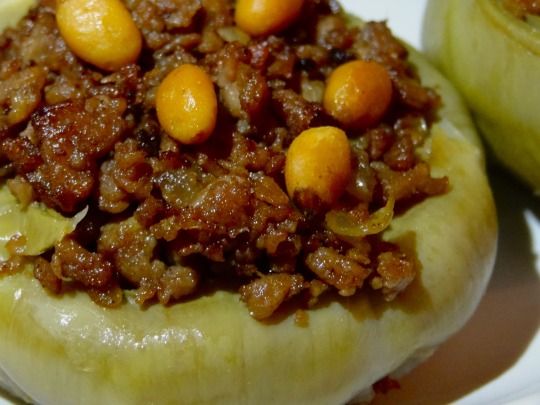
[ID: The first image is of four stuffed artichoke hearts on a plate with a mound of rice and fried vermicelli; the second is a close-up on one artichoke, showing fried ground 'beef' and golden pine nuts. End ID]
أرضي شوكي باللحم / Ardiyy-shawkiyy b-al-lahm (Stuffed artichoke hearts)
Artichoke hearts stuffed with spiced meat make a common dish throughout West Asia and North Africa, with variations on the recipe eaten in Lebanon, Syria, Palestine, Algeria, and Morocco. In Palestine, the dish is usually served on special occasions, either as an appetizer, or as a main course alongside rice. The artichokes are sometimes paired with cored potatoes, which are stuffed and cooked in the same manner. Stuffed artichokes do not appear in Medieval Arab cookbooks (though artichokes do), but the dish's distribution indicates that its origin may be Ottoman-era, as many other maḥshis (stuffed dishes) are.
The creation of this dish is easy enough once the artichoke hearts have been excavated (or, as the case may be, purchased frozen and thawed): they are briefly deep-fried, stuffed with ground meat and perhaps pine nuts, then stewed in water, or water and tomato purée, or stock, until incredibly tender.
While simple, the dish is flavorful and well-rounded. A squeeze of lemon complements the bright, subtle earthiness of the artichoke and cuts through the richness of the meat; the fried pine nuts provide a play of textures, and pick up on the slight nutty taste that artichokes are known for.
Terminology and etymology
Artichokes prepared in this way may be called "ardiyy-shawkiyy b-al-lahm." "Ardiyy-shawkiyy" of course means "artichoke"; "ب" ("b") means "with"; "ال" ("al") is the determiner "the"; and "لَحْم" ("laḥm") is "meat" (via a process of semantic narrowing from Proto-Semitic *laḥm, "food"). Other Palestinian Arabic names for the same dish include "أرضي شوكي محشي" ("ardiyy-shawkiyy maḥshi," "stuffed artichokes"), and "أرضي شوكي على ادامه" ("ardiyy-shawkiyy 'ala adama," "artichokes cooked in their own juice").
The etymology of the Levantine dialectical phrase meaning "artichoke" is interestingly circular. The English "artichoke" is itself ultimately from Arabic "الخُرْشُوف" ("al-khurshūf"); it was borrowed into Spanish (as "alcarchofa") during the Islamic conquest of the Iberian peninsula, and thence into English via the northern Italian "articiocco." The English form was probably influenced by the word "choke" via a process of phono-semantic matching—a type of borrowing wherein native words are found that sound similar to the foreign word ("phonetics"), and communicate qualities associated with the object ("semantics").
"Artichoke" then returned to Levantine Arabic, undergoing another process of phono-semantic matching to become "ardiyy-shawkiyy": أَرْضِيّ ("ʔarḍiyy") "earthly," from أَرْض ("ʔarḍ"), "Earth, land"; and شَوْكِيّ ("shawkiyy") "prickly," from شَوْك ("shawk"), "thorn."
Artichokes in Palestine
Artichoke is considered to be very healthful by Palestinian cooks, and it is recommended to also consume the water it is boiled in (which becomes delightfully savory and earthy, suitable as a broth for soup). In addition to being stuffed, the hearts may be chopped and cooked with meat or potatoes into a rich soup. These soups are enjoyed especially during Ramadan, when hot soup is popular regardless of the season—but the best season for artichokes in the Levant is definitively spring. Stuffed artichokes are thus often served by Jewish people in North Africa and West Asia during Passover.
Artichokes grow wild in Palestine, sometimes in fields adjacent to cultivated crops such as cereals and olives. Swiss traveler Johann Ludwig Burckhardt, writing in 1822, referred to the abundant wild artichoke plants (presumably Cynara syriaca) near لُوبْيا ("lūbyā"), a large village of stone buildings on a hilly landscape just west of طبريا ("ṭabariyya," Tiberias):
About half an hour to the N. E. [of Kefer Sebt (كفر سبط)] is the spring Ain Dhamy (عين ظامي), in a deep valley, from hence a wide plain extends to the foot of Djebel Tor; in crossing it, we saw on our right, about three quarters of an hour from the road, the village Louby (لوبي), and a little further on, the village Shedjare (شجره). The plain was covered with the wild artichoke, called khob (خُب); it bears a thorny violet coloured flower, in the shape of an artichoke, upon a stem five feet in height.
(Despite resistance from local militia and the Arab Liberation Army, Zionist military groups ethnically cleansed Lubya of its nearly 3,000 Palestinian Arab inhabitants in July of 1948, before reducing its buildings and wells to rubble, The Jewish National Fund later planted the Lavi pine forest over the ruins.)
Artichokes are also cultivated and marketed. Elihu Grant, nearly a century after Burckhardt's writing, noted that Palestinian villages with sufficient irrigation "[went] into gardening extensively," and marketed their goods in crop-poor villages or in city markets:
Squash, pumpkin, cabbage, cauliflower, lettuce, turnip, beet, parsnip, bean, pea, chick-pea, onion, garlic, leek, radish, mallow and eggplant are common varieties [of vegetable]. The buds of the artichoke when boiled make a delicious dish. Potatoes are getting to be quite common now. Most of them are still imported, but probably more and more success will be met in raising a native crop.
Either wild artichokes (C. syriaca) or cardoons (C. cardunculus, later domesticated to yield modern commerical artichokes) were being harvested and eaten by Jewish Palestinians in the 1st to the 3rd centuries AD (the Meshnaic Hebrew is "עַכָּבִיּוֹת", sg. "עַכָּבִית", "'aqubit"; related to the Arabic "عَكُوب" "'akūb," which refers to a different plant). The Tosefta Shebiit discusses how farmers should treat the sprouting of artichokes ("קינרסי," "qinrasi") during the shmita year (when fields are allowed to lie fallow), indicating that Jews were also cultivating artichokes at this time.
Though artichokes were persistently associated with wealth and the feast table (perhaps, Susan Weingarten speculates, because of the time they took to prepare), trimming cardoons and artichokes during festivals, when other work was prohibited, was within the reach of common Jewish people. Those in the "upper echelons of Palestinian Jewish society," on the other hand, had access to artichokes year-round, including (through expensive marvels of preservation and transport) when they were out of season.
Jewish life and cuisine
Claudia Roden writes that stuffed artichoke, which she refers to as "Kharshouf Mahshi" (خرشوف محشي), is "famous as one of the grand old Jerusalem dishes" among Palestinian Jews. According to her, the stuffed artichokes used to be dipped in egg and then bread crumbs and deep-fried. This breading and frying is still referenced, though eschewed, in modern Sephardi recipes.
Prior to the beginning of the first Aliyah (עלייה, wave of immigration) in 1881, an estimated 3% of the overall population of Palestine, or 15,011 people, were Jewish. This Jewish presence was not the result of political Zionist settler-colonialism of the kind facilitated by Britain and Zionist organizations; rather, it consisted of ancestrally Palestinian Jewish groups, and of refugees and religious immigrants who had been naturalized over the preceding decades or centuries.
One such Jewish community were the Arabic-speaking Jews whom the Sephardim later came to call "מוּסְתערבים" or "مستعربين" ("Musta'ravim" or "Musta'ribīn"; from the Arabic "مُسْتَعْرِب" "musta'rib," "Arabized"), because they seemed indifferentiable from their Muslim neighbors. A small number of them were descendants of Jews from Galilee, which had had a significant Jewish population in the mid-1st century BC; others were "מגרבים" ("Maghrebim"), or "مغربية" ("Mughariba"): descendents of Jews from Northwest Africa.
Another major Jewish community in pre-mandate Palestine were Ladino-speaking descendents of Sephardi Jews, who had migrated to Palestine in the decades following their expulsion from Spain and then Portugal in the late 15th century. Though initially seen as foreign by the 'indigenous' Mista'avim, this community became dominant in terms of population and political influence, coming to define themselves as Ottoman subjects and as the representatives of Jews in Palestine.
A third, Yiddish- and German-speaking, Askenazi Jewish population also existed in Palestine, the result of immigration over the preceding centuries (including a large wave in 1700).
These various groups of Jewish Palestinians lived as neighbors in urban centers, differentiating themselves from each other partly by the language they spoke and partly by their dress (though Sephardim and Ashkenazim quickly learned Arabic, and many Askenazim and Muslims learned Ladino). Ashkenazi women also learned from Sephardim how to prepare their dishes. These groups' interfamiliarity with each other's cuisine is further evidenced by the fact that Arabic words for Palestinian dishes entered Ladino and Yiddish (e.g. "كُفْتَة" / "kufta," rissole; "مَزَّة" "mazza," appetizer); and words entered Arabic from Ladino (e.g. "דונסי" "donsi," sweet jams and fruit leather; "בוריק" "burek," meat and cheese pastries; "המים" "hamim," from "haminados," braised eggs) and Yiddish (e.g. "לעקעך" "lakach," honey cake).
In addition to these 'native' Jews were another two waves of Ashkenazi migration in the late 18th and early-to-mid 19th centuries (sometimes called the "היישוב הישן," "ha-yishuv ha-yashan," "old settlement," though the term is often used more broadly); and throughout the previous centuries there had also been a steady trickle of religious immigration, including elderly immigrants who wished to die in Jerusalem in order to be present at the appointed place on the day of Resurrection. Recent elderly women immigrants unable to receive help from charitable institutions would rely on the community for support, in exchange helping the young married women of the neighborhood with childcare and with the shaping of pastries ("מיני מאפה").
In the first few centuries AD, the Jewish population of Palestine were largely farmers and agricultural workers in rural areas. By the 16th century, however, most of the Jewish population resided in the Jewish Holy Cities of Jerusalem (القُدس / al-quds), Hebron (الخليل / al-khalil), Safed (صفد), and Tiberias (طبريا / ṭabariyya). In the 19th century, the Jewish population lived entirely in these four cities and in expanding urban centers Jaffa and Haifa, alongside Muslims and Christians. Jerusalem in particular was majority Jewish by 1880.
In the 19th century, Jewish women in Jerusalem, like their Christian and Muslim neighbors, used communal ovens to bake the bread, cakes, matzah, cholent, and challah which they prepared at home. One woman recalls that bread would be sent to the baker on Mondays and Thursdays—but bribes could be offered in exchange for fresh bread on Shabbat. Charges would be by the item, or else a fixed monthly payment.
Trips to the ovens became social events, as women of various ages—while watching the bakers, who might not put a dish in or take it out in time—sent up a "clatter" of talking. During religious feast days, with women busy in the kitchen, some families might send young boys in their stead.
Markets and bakeries in Jerusalem sold bread of different 'grades' based on the proportion of white and wheat flour they contained; as well as flatbread (خبز مفرود / חובז מפרוד / khobbiz mafroud), Moroccan מאווי' / ماوي / meloui, and semolina breads (כומאש / كماج / kmaj) which Maghrebim especially purchased for the Sabbath.
On the Sabbath, those who had brick ovens in their sculleries would keep food, and water for tea and coffee, warm from the day before (since religious law prohibits performing work, including lighting fires, on Shabbat); those who did not would bring their food to the oven of a neighbor who did.
Palestinian Jewish men worked in a variety of professions: they were goldsmiths, writers, doctors, merchants, scientists, linguists, carpenters, and religious scholars. Jewish women, ignoring prohibitions, engaged in business, bringing baked goods and extra dairy to markets in Jerusalem, grinding and selling flour, spinning yarn, and making clothing (usually from materials purchased from Muslims); they were also shopkeepers and sellers of souvenirs and wine. Muslims, Jews, and Christians shared residential courtyards, pastimes, commercial enterprises, and even holidays and other religious practices.
Zionism and Jewish Palestinians
Eastern European Zionists in the 1880s and 90s were ambivalent towards existing Jewish communities in Palestine, often viewing them as overly traditional and religious, backwards-thinking, and lacking initiative. Jewish Palestinians did not seem to conform with the land-based, agricultural, and productivist ideals of political Zionist thinkers; they were integrated into the Palestinian economy (rather than seeking to create their own, segregated one); they were not working to create a Jewish ethnostate in Palestine, and seemed largely uninterested in nationalist concerns. Thus they were identified with Diaspora Jewish culture, which was seen as a remnant of exile and oppression to be eschewed, reformed, or overthrown.
These attitudes were applied especially to Sephardim and Mista'arevim, who were frequently denigrated in early Zionist literature. In 1926, Revisionist Zionist leader Vladimir Jabotinsky wrote that the "Jews, thank God, have nothing in common with the East. We must put an end to any trace of the Oriental spirit in the Jews of Palestine." The governance of Jewish communities was, indeed, changed with the advent of the British Mandate (colonial rule which allowed the British to facilitate political Zionist settling), as European political and "socialist" Zionists promoted Ashkenazi over Sephardi leadership.
Under the Ottomans, the millet system had allowed a degree of Jewish and Christian autonomy in matters of religious study and leadership, cultural and legal affairs, and the minting of currency. The religious authority of all Jewish people in Palestine had been the Sephardi Rabbi of Jerusalem, and his authority on matters of Jewish law (like the authority of the Armenian Patriarchate on matters of Christian law) extended outside of Palestine.
But British and European funding allowed newer waves of Ashkenazi settlers (sometimes called "היישוב החדש," "ha-yishuv ha-khadash," "new settlement")—who, at least if they were to live out the ideals of their sponsors, were more secular and nationalist-minded than the prior waves of Ashkenazi immigration—to be de facto independent of Sephardi governance. Several factors lead to the drying up of halaka (donated funds intended to be used for communal works and the support of the poor in Sephardi communities), which harmed Sephardim economically.
Zionist ideas continued to dominate newly formed committees and programs, and Palestinian and Sephardi Jews reported experiences of racial discrimination, including job discrimination, leading to widespread poverty. The "Hebrew labor" movement, which promoted a boycott of Palestinian labor and produce, in fact marginalized all workers racialized as Arab, and promises of work in Jewish labor unions were divided in favor of Ashkenazim to the detriment of Sephardim and Mizrahim. This economic marginalization coincided with the "social elimination of shared indigenous [Palestinian] life" in the Zionist approach to indigenous Jews and Muslims.
Despite the adversarial, disdainful, and sometimes abusive relationship which the European Zionist movement had with "Oriental" Jews, their presence is frequently used in Zionist food and travel writing to present Israel as a multicultural and pluralist state. Dishes such as stuffed artichokes are claimed as "Israeli"—though they were eaten by Jews in Palestine prior to the existence of the modern state of Israel, and though Sephardi and Mizrahi diets were once the target of a civilizing, correcting mission by Zionist nutritionists. The deep-frying that stuffed artichokes call for brings to mind European Zionists' half-fascinated, half-disgusted attitudes towards falafel.
The point is not to claim a dish for any one national or ethnic group—which is, more often than not, an exercise in futility and even absurdity—but to pay attention to how the rhetoric of food writing can obscure political realities and promote the colonizer's version of history. The sinking of Jewish Palestinian life prior to the advent of modern political Zionism, and the corresponding insistence that it was Israel that brought "Jewish cuisine" to Palestine, allow for such false dichotomies as "Jewish-Palestinian relations" or "Jewish-Arab relations"; these descriptors further Zionist rhetoric by making a clear situation of ethnic cleansing and settler-colonialism sound like a complex and delicate issue of inter-ethnic conflict. To boot, the presentation of these communities as having merely paved the way to Zionist nationalism ignores their existence as groups with their own political, social, and cultural lives and histories.
Help evacuate a Gazan family with Operation Olive Branch
Buy an eSim for use in Gaza
Help Anera provide food in Gaza
Ingredients:
Serves 4 (as a main dish).
For the artichokes:
6 fresh, very large artichokes; or frozen (not canned) whole artichoke hearts
1 lemon, quartered (if using fresh artichokes)
250g (1 1/2 cups) vegetarian ground beef substitute; or 3/4 cup TVP hydrated with 3/4 cup vegetarian 'beef' stock from concentrate
1 yellow onion, minced
Scant 1/2 tsp kosher salt
1/2 tsp ground black pepper
1 pinch ground cardamom (optional)
1/4 tsp ground allspice or seb'a baharat (optional)
1 Tbsp pine nuts (optional)
Water, to simmer
Oil, to fry
2 tsp vegetarian 'beef' stock concentrate, to simmer (optional)
Lemon, to serve
Larger artichokes are best, to yield hearts 3-4 inches in width once all leaves are removed. If you only have access to smaller artichokes, you may need to use 10-12 to use up all the filling; you might also consider leaving some of the edible internal leaves on.
The meat may be spiced to taste. Sometimes only salt and black pepper are used; some Palestinian cooks prefer to include seb'a baharat, white pepper, allspice, nutmeg, cardamom, and/or cinnamon.
Medieval Arab cookbooks sometimes call for vegetables to be deep-fried in olive oil (see Fiḍālat al-Khiwān fī Ṭayyibāt al-Ṭaʿām wa-l-Alwān, chapter 6, recipe no. 373, which instructs the reader to treat artichoke hearts this way). You may use olive oil, or a neutral oil such as canola or sunflower (as is more commonly done in Palestine today).
Elihu Grant noted in 1921 that lemon juice was often served with stuffed vegetable dishes; today stuffed artichokes are sometimes served with lemon.
For the rice:
200g Egyptian rice (or substitute any medium-grained white rice)
2 tsp broken semolina vermicelli (شعيريه) (optional)
1 tsp olive oil (optional)
Large pinch salt
520g water, or as needed
Broken semolina vermicelli (not rice vermicelli!) can be found in plastic bags at halal grocery stores.
Instructions:
For the stuffed artichokes:
1. Prepare the artichoke hearts. Cut off about 2/3 of the top of the artichoke (I find that leaving at least some of the stem on for now makes it easier to hollow out the base of the artichoke heart without puncturing it).
2. Pull or cut away the tough outer bracts ("leaves") of the artichoke until you get to the tender inner leaves, which will appear light yellow all the way through. As you work, rub a lemon quarter over the sides of the artichoke to prevent browning.
3. If you see a sharp indentation an inch or so above the base of the artichoke, use kitchen shears or a sharp knife to trim off the leaves above it and form the desired bowl shape. Set aside trimmings for a soup or stew.
4. Use a small spoon to remove the purple leaves and fibers from the center of the artichoke. Make sure to scrape the spoon all along the bottom and sides of the artichoke and get all of the fibrous material out.
5. Use a paring knife to remove any remaining tough bases of removed bracts and smooth out the base of the artichoke heart. Cut off the entire stem, so that the heart can sit flat, like a bowl.
6. Place the prepared artichoke heart in a large bowl of water with some lemon juice squeezed into it. Repeat with each artichoke.
7. Drain artichoke hearts and pat dry. Heat a few inches of oil in a pot or wok on medium and fry artichoke hearts, turning over occasionally, for a couple minutes until lightly browned. If you don't want to deep-fry, you can pan-fry in 1 cm or so of oil, flipping once. Remove with a slotted spoon and drain.
8. Prepare the filling. Heat 1 tsp of olive oil in a large skillet on medium-high and fry onions, agitating often, until translucent.
Tip: Some people add the pine nuts and brown them at this point, to save a step later. If you do this, they will of course be mixed throughout the filling rather than being a garnish on top.
9. Add spices, salt, and meat substitute and fry, stirring occasionally, until meat is browned. (If using TVP, brown it by allowing it to sit in a single layer undisturbed for 3-4 minutes, then stir and repeat.) Taste and adjust spices and salt.
10. Heat 1 Tbsp of olive oil or margarine in a small pan on medium-low. Add pine nuts and fry, stirring constantly, until they are a light golden brown, then remove with a slotted spoon. Note that, once they start taking on color, they will brown very quickly and must be carefully watched. They will continue to darken after they are removed from the oil, so remove them when they are a shade lighter than desired.
11. Stuff the artichoke hearts. Fill the bowl of each heart with meat filling, pressing into the bottom and sides to fill completely. Top with fried pine nuts.
12. Cook the artichoke hearts. Place the stuffed artichoke hearts in a single layer at the bottom of a large stock pot, along with any extra filling (or save extra filling to stuff peppers, eggplant, zucchini, or grape leaves).
13. Whisk stock concentrate into several cups of just-boiled water, if using—if not, whisk in about a half teaspoon of salt. Pour hot salted water or stock into the pot to cover just the bottoms of the stuffed artichokes.
14. Simmer, covered, for 15-20 minutes, until the artichokes are tender. Simmer uncovered for another 5-10 minutes to thicken the sauce.
For the rice:
1. Rinse your rice once by placing it in a sieve, putting the sieve in a closely fitting bowl, then filling the bowl with water; rub the rice between your fingers to wash, and remove the sieve from the bowl to strain.
2. Place a bowl on a kitchen scale and tare. Add the rice, then add water until the total weight is 520g. (This will account for the amount of water stuck to the rice from rinsing.)
3. (Optional.) In a small pot with a close-fitting lid, heat 1 tsp olive oil. Add broken vermicelli and fry, agitating often, until golden brown.
4. Add the rice and water to the pot and stir. Increase heat to high and allow water to come to a boil. Cover the pot and lower heat to a simmer. Cook the rice for 15 minutes. Remove from heat and steam for 10 minutes.
To serve:
1. Plate artichoke hearts on a serving plate alongside rice and lemon wedges; or, place artichoke hearts in a shallow serving dish, pour some of their cooking water in the base of the dish, and serve rice on a separate plate.
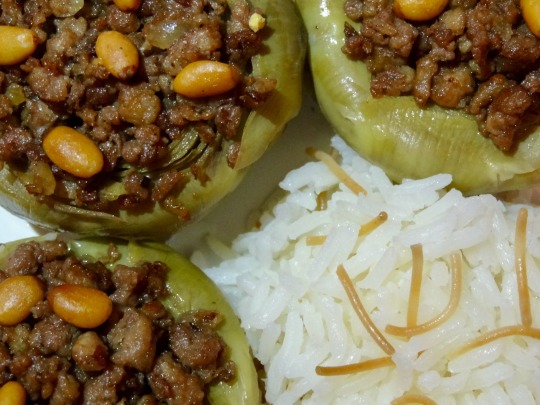
Tip: The white flesh at the base of the bracts (or "leaves") that you removed from the artichokes for this recipe is also edible. Try simmering removed leaves in water, salt, and a squeeze of lemon for 15 minutes, then scraping the bract between your teeth to eat the flesh.
170 notes
·
View notes
Text
The Asteri, the Daglan, and Prythian's Court System
Disclaimer: this is a stupidly massive crack theory that could end up being disastrously wrong. Oh well.
Spoilers: the ACOTAR and CC series to date (I'm halfway through HOFAS right now, slowly plodding along, so nothing beyond that).
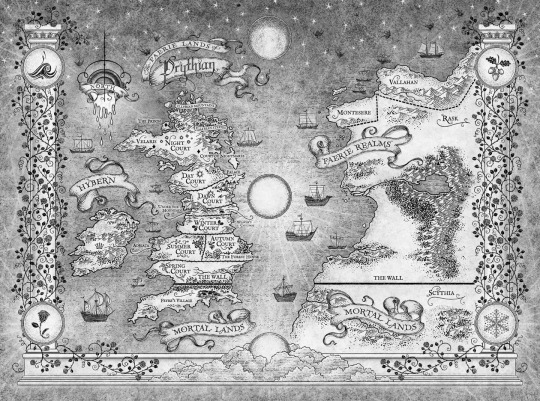
Image from ACOSF, Kindle edition.
Buckle up for some more of my nonsense! I think I could have discovered why Prythian's land has the Court and High Lord Systems. This theory still has a couple of wrinkles to iron out, but it's plausible, so I figured I'd share what I've got.
A massive thank you goes to @ladynightcourt3 and @psychologynerd for our chat yesterday morning, which led to this post. I love you guys! 💜
Full warning that this will A) be absolutely cracked, and B) contains Maasverse spoilers, including from HOFAS (up to around 40% I think), but I was mulling over what I'd read so far and this popped into my mind.
Part 1 - The Court System
Bryce made, I think, one hell of an assumption when she said the following in HOFAS:
Vesperus, the only Asteri left on this world, lay dead. - CC HOFAS, chapter 26
@wingedblooms and I have previously theorised that some of the barren regions in Prythian may be so because the death gods were trapped there, drinking the magic of the land, rendering it spent - lifeless - and possibly unable to power up a gateway to an interstellar rift. We both also think it's very interesting that one Elain Archeron was referred to as “a rose bloom in a mud field,” but I digress.
However, in HOFAS, we learnt that there was a Daglan/Asteri, called Vesperus (who considered herself the Evening Star and their god), trapped in a crystal coffin far below the Prison, which was once a land of Dusk.
The female’s long nails scraped along the lid of the coffin. She didn’t look at them as she tested the lid for weaknesses. “I am your god. I am your master. Do you not know me?” - CC HOFAS, chapter 24
It's interesting, no, that the region was named after the Daglan who ruled it? Was this common practice? Because we just so happened to learn, in Feysand’s ACOSF bonus chapter, that there was once an ancient Night Court goddess named Nyx.
You know, their son's namesake? Yikes. 🫣
“You may call me Vesperus.” The creature’s eyes glowed with irritation. “Are you related to Hesperus?” Bryce arched a brow at the name, so similar to one of Midgard’s Asteri. “The Evening Star?” “I am the Evening Star,” Vesperus seethed. - CC HOFAS, chapter 25
Silene, Theia's second daughter, who “escaped into the night,” gave us further information that appeared - to me, at least - to be incomplete. Or perhaps inaccurate? She had been taught by her mother, so she could have been fed certain things as facts. For example, was the land of Prythian really divvied up into seasons and times of day before the Daglan came to town?
The land strengthened. It returned to what it had been before the Daglan’s arrival millennia before. We returned to what we’d been before that time, too, creatures whose very magic was tied to this land. Thus the land’s powers became my mother’s. Dusk, twilight—that’s what the island was in its long-buried heart, what her power bloomed into, the lands rising with it. It was, as she said, as if the island had a soul that now blossomed under her care, nurtured by the court she built here. - CC HOFAS, chapter 19
The Cauldron was of our world, our heritage. But upon arriving here, the Daglan captured it and used their powers to warp it. To turn it from what it had been into something deadlier. No longer just a tool of creation, but of destruction. And the horrors it produced … those, too, my parents would turn to their advantage. - CC HOFAS, chapter 19
My sister and I grew older. My mother educated us herself, always reminding us that though the Daglan had been vanquished, evil lived on. Evil lurked beneath our very feet, always waiting to devour us. - CC HOFAS, chapter 19
Reading between the lines, I think it's just possible to link the powers of each land with the Daglan who once ruled over them. Perhaps each region - each “precursor” to a modern day Court - had a Daglan/Asteri buried underneath a barren peak, or in a body of water? Is this why the lands have frozen seasons, pools of starlight*, or powers based upon the light of the time of day? Because of a monster buried far, far below the surface?!
*Is there a Daglan entombed in a crystal coffin far below the surface, or is it a cache of firstlight, one that may be refuelled each Calanmai? Or, as @psychologynerd has suggested, is there a Made object of power that will draw Elain to the Spring Court?
Our home had been left empty since we’d vanished. As if the other Fae thought it cursed. So I made it truly cursed. Damned it all. - CC HOFAS, chapter 21
Despite my efforts to hide what this place had once been, a terrible, ancient power hung in the air. It was as my mother had warned us when we were children: evil always lingered, just below us, waiting to snatch us into its jaws. So I went to find another monster to conceal it. - CC HOFAS, chapter 21
I left, wandering the lands for a time, seeing how they had moved on without Theia’s rule. They’d splintered into several territories, and though they were not at war, they were no longer the unified kingdom I had known. - CC HOFAS, chapter 21
As a quick aside, I still suspect that Fionn may have been a Daglan - or similar, perhaps an Under King - who tricked Theia into thinking him a normal faerie and used her to overthrow his peers in order to gain more land for himself. It seems exactly like something a rogue Asteri would do.
Like I suggested earlier, could each region be named for its ruler? Because the names of at least one of the Midgard Asteri was, shall we say, coincidentally similar to the Daglan of Prythian, and others appear to match at least the solar courts.
Solar:
Dawn - Eosphoros
Day - Rigelus
Dusk - Hesperus
Night - Sirius
Seasonal (incomplete/unsure/probably incorrect):
Spring - Austrus?
Summer - Octartis?
Autumn - ?
Winter - Polaris?
As I said, the Midgardian Asteri don't perfectly match up to the seasonal Prythian courts, but it's too close to not consider as a possibility, imo.
Perhaps the lands of Midgard were broken up into solar regions and something else that wasn't seasonal? But given the Vesperus/Hesperus competition... maybe whatever species Asteri and/or Daglan are are strongest when travelling with a full complement of powers? And each "clan" (for lack of a better word) that travelled together had dawn, day, dusk, and night “lights,” as well as spring, summer, autumn and winter lights? Could it weaken them to be without a full cohort of powers? As @ladynightcourt3 said, it would explain why they were so upset about Sirius. Could Rigelus be hoping for a replacement to find them and return them to full strength, and that's why he keeps an empty throne?
Part 2 - The High Lords
No one knew that the infant who sometimes glowed with starlight had inherited it from me. That it was the light of the evening star. The dusk star. - CC HOFAS, chapter 21
An Asteri being buried under each Court could explain the high lord magic as well.The HLs are “a different breed,” per Lucien. Did the Asteri/Daglan need a Starborn Fae who is predisposed to holding, or withstanding, their magic? If this is the case, it would explain why the next in line to inherit the power - or who the magic chooses - isn't always a direct descendant of the previous high lord. Does it pass to the Fae with the strongest Starborn blood? And why the mountain shook when Mor got her first period. There has to be a Daglan/Asteri buried under the Hewn City.
That being said, why is it only men who can inherit the magic, and not women, especially when we now know that high ladies used to exist? Did Theia's betrayal made them distrust females in general, or was it something Seline did? Or is it because the women have the most/purest/strongest, starborn power, so did the men keep them down to use them as “breeding stock” in order to legitimise their rule, similar to what Pelias did with Helena?
Part 3 - Further Thoughts
I still wonder how Hybern and Hel could come into play here, because I think those lands are linked. A Valg/Hel Prince population on a different island?
@psychologynerd noted that we’ve previously connected the solar and seasonal courts, such Dawn = Spring, Day = Summer etc., and that it would track for Autumn and Dusk - an appropriately matched pair - to migrate together to Midgard. As an aside, this could tie in with the parallels shared by Azriel and Lucien, who may be/are linked to Dusk and Autumn. What if their power was connected via their “stars”?
@ladynightcourt3 wondered if Hesperus may have changed her name, hence Vesperus’ anger.
I can understand how a Daglan's presence may impart their magic into the land, especially if they're left buried - steeping? - in the soil for millennia, but how would that magic shape the faeries living there? Is it like I suggested in this post, that prolonged exposure to a powerful object allows a tie to be forged?
A bonus crack theory for fun - what if Merrill is a trapped Asteri? Either Nyx or Sirius, whom Apollion ate, and perhaps she escaped the pit of Hel through the base of the House of Wind library; nobody knows where she came from, she's descended from Rabbath of the Western Wind… her room is described as a cell and she called Nesta “girl” like Amren - an ancient - did. I dunno, but there's something about Merrill.
As always, thank you for reading! 💜
#hosab spoilers#hofas spoilers#acotar cc tog crossover theory#acotar theory#the dusk court#dusk court#the night court#night court#prythian#acotar#sjm books#maasverse#feysand#feyre archeron#rhys acotar#crack theory
107 notes
·
View notes
Text
Cooking Prompts
A asks B to do a quick grocery store trip for them since they forgot something they need for the recipe. Yet when B comes back, grocery bags in their hands, the one thing A asked for is nowhere to be seen.
A has spent all day cooking for a gathering planned with friends/B’s family, while B – never having tasted A’s creations before – has spent it looking forward to the meal. (That attitude changes quickly when they see the faces their friends/family members make upon tasting the food.)
A decides/agrees to finally share their well-kept secret family recipe with B.
“I never thought seeing someone cut up bell peppers could be so hot.”
A only left for two minutes, thinking the time window would be too small for B to ruin the food. (They were wrong. It wasn’t.)
To cheer up/etc. A, B creates – or at least tries to – something artistic with the food. (e.g. a pancake heart or an apple swan)
A wakes up in the middle of the night to B cooking in the kitchen.
“Here. Try this.”
When A arrives home, they find B making homemade pasta and drying it on the clothing drying rack/back of a chair/coat hangers/etc.
“Stop distracting me. (I can’t burn the food again because you can’t stay away from me.)”
A has had a long, exhausting day. So when they come home, no strength left to cook anything, and find B standing on their doorsteps and holding a plate with food they cooked just for them, their heart warms.
“I don’t know how you can eat that.”
A can’t cook, so B teaches them some basics.
A and B are so caught up in one another that they don’t mind their surroundings. When A leans backwards to make B chase their lips/etc., their hand lands on the (still) warm hot plate/moves so that cutlery falls to the ground/etc.
A helps B to cook something just to spend time with them/etc. They are caught off guard when B invites them to eat the meal with them.
“It’s not that good/bad/spicy.”
A catches B throwing spaghetti at the wall.
“Oysters? Are you trying to seduce me, [name]?”
A (tries to) surprise(s) B with a candlelight dinner at home. (Somehow, however, everything that could go wrong does.)
A watches B flip pancakes/etc. without a spatula. They too want to learn how to do it.
“Five-second rule!”
A and B are both convinced that their respective version of a certain meal is the superior one. So they make it a competition and invite over friends/etc. to play judge.
A is annoyed at seeing B cut the vegetables/fruits into the wrong shape. (Slices just taste better in/with this particular meal than dices do.)
The fridge currently houses A’s favorite meal, and they cannot resist sneaking into the kitchen and taking a couple of bites of it.
#writing prompts#writing inspiration#cooking prompts#activity prompts#kitchen prompts#domestic prompts#couple prompts#writing ideas#prompt list#person a and person b
147 notes
·
View notes
Text
On Shrine Maidens, Gods, and the History of Gensoukyou
My personal opinion is that shrine maiden #13 (from the PCB prologue) is Reimu's predecessor; the attitude that she holds is similar to PC-98 Reimu's, in that both seem to be aware of youkai as a problem but neither act especially threatened by them. The "kind of an airhead" trait seems to be common among shrine maidens.

Now, why do I think that she's the thirteenth shrine maiden since Gensoukyou was founded, specifically? That's primarily because the Hakurei Shrine has... well... a lot wrong with it in the modern day. A god of youkai extermination is working alongside youkai.


Explicitly not for the purposes of youkai extermination, at that:

You could see them as a collaborator in the Gensoukyou project, except for this:

If they were aware and a willing architect of Reimu's job being just "to balance between humans and youkai" rather than "to tend the shrine", it would be hard for them to be angry because she's always off doing her job. I think it's quite likely that they're angry about the fact that A.) They've been forgotten entirely and B.) Their shrine maiden is working with youkai instead of exterminating them.
There's another piece of the puzzle in terms of their role in Gensoukyou:

A youkai calling the Hakurei Shrine her shrine. Not "our" shrine, like you'd expect if the Hakurei God was a collaborator on this project- Yukari's shrine specifically. (Of course, we can conclude from the "god of youkai extermination" and "the god of this shrine is angry" comments that Yukari isn't a god playing at being a youkai, either.) The Hakurei Shrine, as it currently stands, is something that you can consider an "artificial creation of youkai."

Rinnosuke comes to a similar conclusion.
So, the Hakurei Shrine is a defiled mockery of a shrine, that much is true. But what does that have to do with shrine maiden lifespans? Well, if the shrine was created in its current form alongside Gensoukyou, that implies about 140 years of history. (138, to be specific, but let's not bother with the details. This will still be on my blog by 2025, hopefully.) We get the 13th Hakurei shrine maiden's inscription (presumably before the year 1996, since she's not Reimu.) describing the current conditions of Gensoukyou as similar to those of the PC-98 games.
However, how do we know that she's the 13th shrine maiden since Gensoukyou was created, rather than simply since the Hakurei Shrine was founded? Well, it's a simple process of inference. The Hakurei Shrine prior to Gensoukyou as it is today was likely a proper youkai-exterminating shrine.

That it has become what it is now is a surprising discontinuity.

There aren't any records that remain to tell what the Hakurei God's name is, which is somewhat odd; you'd think that in a land which has been known as a place where youkai extermination is necessary for hundreds of years, people would remember that there was a god of it.
That is to say, the records probably didn't just stop being kept; they were probably deliberately lost, or destroyed. But we have the 13th Hakurei Shrine Maiden's inscription of Gensoukyou's current state- so it isn't like all records of what happen with the shrine disappear.
It's easy to infer, under these conditions, what happened. The god of youkai extermination, losing influence as youkai also lost influence, had a shrine that nobody visited any more. Youkai viewed that shrine as a good keystone for the barrier surrounding Gensoukyou, due to its location, and revived it, beginning a new series of shrine maidens entirely; the first Hakurei shrine maiden was, of course, the first since that revival. The god in there didn't gain anything from this, of course; there's no reason for the youkai to allow it to, and in fact it would be quite inconvenient if people knew the shrine's blessing was really youkai extermination.
But 14 shrine maidens is quite a lot in 140 years. That's an average tenure of a little more than 9 years per shrine maiden! (Excluding Reimu, it's around 8.5). It was, of course, a fairly dangerous job prior to the spell card rules; we don't know how dangerous, though. Or do we?

Thank you very much, Komachi, for solving the mystery of the shrine.
159 notes
·
View notes
Text
THEORY: “Welcome Home, my son…”
For a while I wondered why puppets are used specifically to help tell the story of this ARG? Then it was brought to my attention from another Welcome Home fan that maybe there are some parallels to the story of Pinocchio. In versions of the story, Geppetto had a real son that passed away and from his grief he created a wooden puppet that looked like his son, who would later become Pinocchio.
I also think it kind of is that way because there’s a big emphasis on family and children/babies in this update. With Howdy’s family coming over for the Homewarming, Julie and Frank trying to get everyone to be quiet so they don’t wake up the flowers and bugs that are hibernating (which is something parents do when they don’t want any loud noises that could wake up a sleeping baby), and the commercials targeted towards children, also Frank singing a lullaby and Wally singing a song about children going to a place called Toy Land and never leaving.
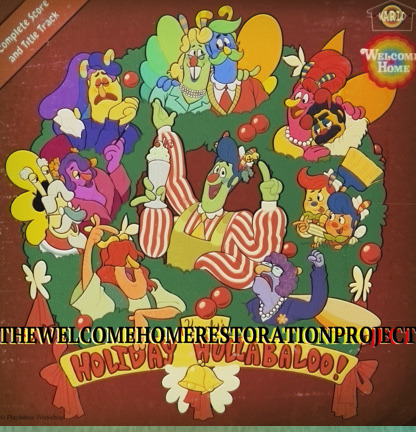
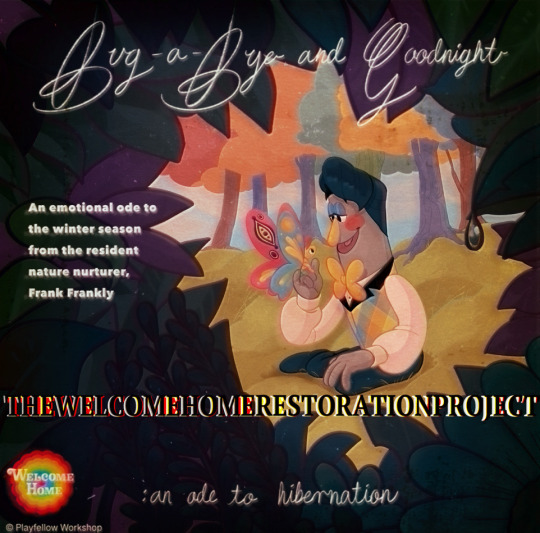
Then it hit me, sorry if any of this sounds fanfic-y or if I’m reaching a bit, but this is what think could be going on.
In the early-mid 60s, Ronald Dorelaine was a children’s entertainer, specializing in puppetry. He ran a troupe with some of his other puppeteer friends called “The Playfellow Puppets” and they would put on little puppet shows as part of the children’s theater slot at the local community centers.
The cast of characters included (and in order of creation): Julie Joyful (she was the first created since she’s a simple hand rod puppet), Frank Frankly, Eddie Dear, Sally Starlight, Howdy Pillar, and Poppy Partridge.
Since a part of me feels like almost everyone else was created before Wally and Home also it would make sense if Poppy was kind of “new” since she’s the most complex puppet to operate.
Ronald Dorelaine had a young son who would often tag along during his father’s performances, and his son’s named was Walliford, but sometimes his dad would call him “Wally.” Walliford was very fascinated with his father’s work and the characters he created, and one of his favorite things to do was draw and paint, hoping that someday he would create something when he grows up just like his father. Walliford even helped Ronald come up with a new character for “The Playfellow Puppets.” Barnaby B. Beagle. A blue dog that was inspired by one of his son’s drawings.

Which would explain this.
Ronald’s puppet shows started becoming so popular that it even started gaining attention from producers of a local tv station (sort of similar to PBS) where they offered Ronald the idea to turn his puppet show into a television series. Ronald took up on the offer, and the show began to develop. However a tragedy would soon happen….
Ronald was a heavy smoker (hence why there is a a big emphasis on cigarette ads in the recent update):

One day when trying to discard a cigarette before Ronald had to leave the house (possibly to go to a last minute meeting with the producers that would be helping him develop his new tv show). However he was unaware that the cigarette was still lit, and it set a fire to his home. Ronald was safe because he wasn’t in the house at the time of the fire, but his son Walliford was nowhere to be found and his body was never recovered so he’s presumed dead.
(Probably hinted at when Home’s eyes turned red in the commercial compilations)
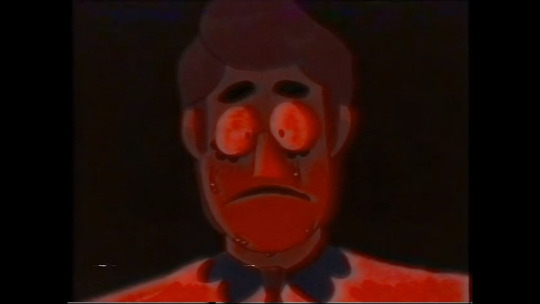

I also think maybe Eddie’s puppeteer was a witness or somehow involved with this incident (possibly because he agreed to watch Walliford while his dad went out) since I noticed during his breakdown, everything turned bright red and Eddie looks like he feels guilty about something, hence why he’s sweating and Home appears to be starring him down as if he did something.
From his grief and in order to cope with the loss of his son, Ronald created a new character as a tribute to him. Wally Darling, and from there the plot of the show changed. The show would now be about a neighborhood, all of the previous characters would be neighbors with Wally Darling, who would now be the lead of the show. Ronald also added some traits that were present in Walliford, such as his love for art and his friendship with Barnaby (who was Walliford’s favorite of the group) for the new Wally character.
Then for a last minute edition, Ronald included a sentient home for Wally to live in. The Home was meant to keep Wally the puppet safe and to watch out for him, which was something he wasn’t able to do for his son.
Hence why the title of the show changed to “Welcome Home,” since to him he wanted it to feel like his son now has a second chance at life and he’s finally back home where he belongs. Almost like saying “Welcome home, my son.”
However none of this was enough for Ronald, even though he created a new character to keep Walliford’s memory alive, it was hard for him to find a puppeteer to play Wally because it wasn’t the same. All he really wanted was his son back and he would go to whatever means necessary even if it means going to the extreme. He later came across “the entity” and made a wish for Wally Darling to become real (like how Geppetto wished for Pinocchio to be real and The Blue Fairy brought him to life). And with that his wish came true. Wally was now sentient without the use of puppeteer.
I kind of believe this to be the case because Wally to me feels like the odd man out, everyone else feels lively and zany since they’re real people, while Wally just feels like a blank slate, with the way he speaks sounding very monotone. Here there was a bit of an innocence to Wally since he’s always learning things for the first time and asking questions about certain concepts and feelings, since he was literally a puppet brought to life and “the baby” of the group. However the producers, and parents watching the show didn’t think it was odd since they thought Wally was like this since he was meant to be a character that children can project themselves onto.
However what everyone didn’t know is that the entity that helped bring Wally to life manifested it’s way into the show possessing The Home puppet, and since Wally had no one attached to a real person playing him, the entity used Wally as a vessel to carry out their agenda. Day after day, the show started to go more and more off the rails, but what was really happening was through Wally the entity started to brainwash each of the puppeteers into believing that they were the actual characters, possibly by using the sleeping pills advertised in the commercials, or there was foul play on Ronald’s end and he gave all his puppeteers the sleeping pills to “put them out of their misery.”
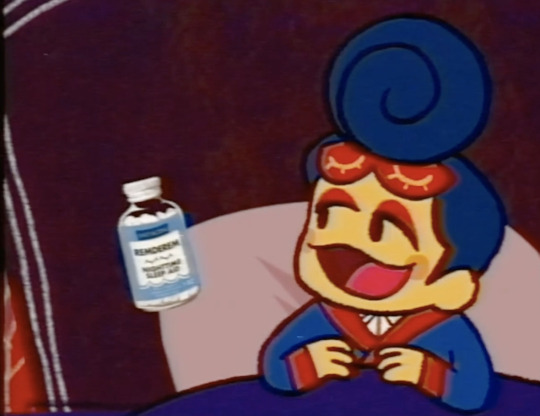
By 1974, Ronald tried to put a stop to the entity, and he had no other choice but to end the show and destroy all the evidence that it ever happened. Ronald himself also began to slowly disappear from the public eye and he hasn’t been seen since then.
For years “Welcome Home” has gone on being a lost media, until now.
That’s not the end of story, because it turns out the real Wally Darling, Walliford Dorelaine, is actually still alive, but he has amenesia from the incident and he was no memories of his previous life. Doesn’t know what his real name is (it probably started with a W) or who his parents were, which is why he was never brought back to Ronald. By the time Walliford grew up, his friends started talking about this mysterious puppet show that was on TV years ago called “Welcome Home” which was kind of like Sesame Street, but they all thought it was some kind of urban legend. Then suddenly Walliford started getting all these tattered artwork and pictures of merchandise from the show they were talking about, and he showed it to his friends and together they formed The Welcome Home Restoration Group to try and uncover the mysterious Welcome Home show.
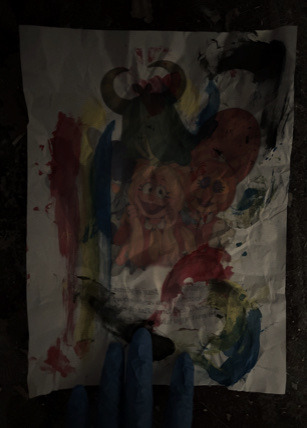
Walliford however started experiencing strange feelings both physically and mentally. There were times when he doubted if the show was even real, but whenever he did have any doubt, he had dreams and hallucinations of Wally Darling trying to communicate with him through the phone and he also starts seeing all these strange video clips from the show itself sprinkled throughout the website that he and the team built. The team however started growing concerned for Walliford thinking that he “lost his mind” so they kindly tried to distance themselves from him while they are trying to rebrand the site after seeing that Walliford was trying to communicate with what he believed to be Wally Darling haunting the site, before they shut it down.

This only caused Walliford to create his own website with his own evidence, since it seems like his own restoration team is starting to mistrust him, and now he’s going to get to the bottom of this all by himself.
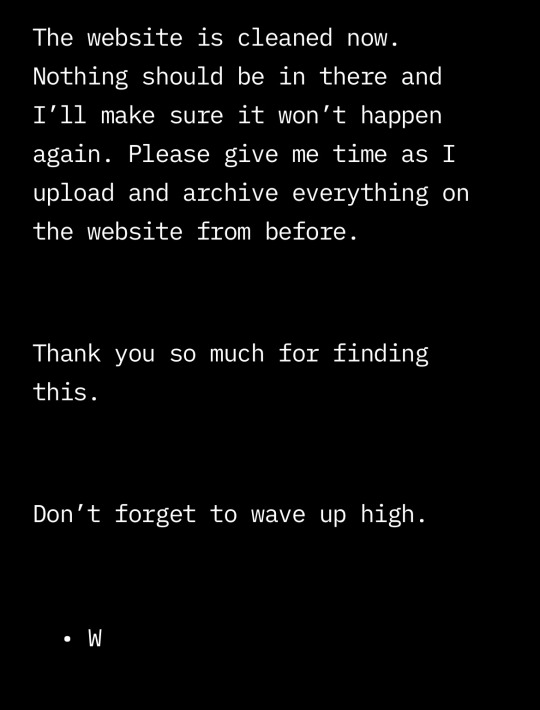
But what they all don’t know is that Walliford’s connection to “Welcome Home” goes much deeper than that, as it’s in his blood.
#welcome home#welcome home arg#wally darling#barnaby b beagle#julie joyful#frank frankly#eddie dear#sally starlight#howdy pillar#poppy partridge#welcome home theory#welcome home puppet show
115 notes
·
View notes
Text
so here's the thing...
i've written about this topic a few times during and after season 1, but the carmy and sydney of it all remains a highly contested and discussed topic. even after season two.
what i find so truly fascinating is that chris storer and joanna calo and everyone involved with the creation of this lovely, well constructed show absolutely could have created the duo they work SO hard in the press to convince viewership they intended.
if they really wanted sydney to be a psuedo/standin sibling for the one carmy lost, or the brainy, determined business partner that comes in to orient a sinking ship...
there are a couple hundred ways they could have managed that and made it abundantly clear that's what the angle was within the dynamic between carmy and sydney.
instead... we have all this very overtly (and covertly) romantic, potent and simmering subtext regarding the nature of their relationship and what they mean to one another, their effect on each other and their seemingly endless potential.
in a whole host of ways there are a number of scenes that literally don't make sense without the lens of the undercurrent of feelings or reverence or romance or something that exists between them beyond the intended business partners/co-creatives.
there are ways to narratively parallel sydney as a mirror and equal and peer of carmy's void of all ambiguity and romantic tension and any energy of awkward longing or confusion.
but that's not actually what we got. i've been consuming television media for most of my life. i've watched hundreds of shows; shipping has never been a requirement for my viewership or interest.
which leads me to believe that there's either a bunch of deflection/dismissing happening for a very distinct reason. or there's been a bait and switch planned from the beginning.
you would literally have to remove 75% of the nuance within carmy and sydney's interactions for the stictly platonic claims to make sense and effectively land.
you'd have to go through and remove various staging, shot selection, editing, music choices and sometimes entire scenes to accurately convey original or "intended" messaging.
to completely eradicate the liminal space of subjectivity between them.
why is carmy talking about tina looking like sydney with that distinct expression on his face when they all wear that apron?
why are they being awkward at the lockers like it isn't customary for coworkers and business partners to go out after work for dinner or drinks or whatever (literally evidenced by tina this season)?
why is sydney mentioning jealousy at all when it comes to carmy's relationship? especially when it makes perfect sense for her to be upset with him for not pulling his weight?
why is sydney entering into carmy's life for the first time and deciding to stay, the second time, something that literally brings him out of his panic? when it could have been him cooking, his drawings, his staff, his gf. ANYTHING else.
they effectively made sydney an emotional, mental and energetic tether for him in that scene. for what reason? business partner ones or????
why do they bicker like an old married couple? is that customary for creative collaborators and coworkers?
why superimpose sydney, parallel her doing something the audience saw carmy do last season, and then show her going about her night while he's by contrast, with his girlfriend? why show a random closeup of a meaningful tattoo on her shoulder? no thematic significance beyond the grind of the restaurant world and career ambition?
why is there an obvious awkward breaking of energy after a highly vulnerable and tender moment between the two of them under the table? why does sydney noticeably fidget/adjust herself/her apron when he walks away to get her gift?
there's actually a hundred instances of these questions you could ask over the course of the two seasons when it comes to them.
so the reasoning behind the shipper pushback is baffling and a bit laughable.
some people bring into question, perhaps this is just the natural chemistry that jaw and ayo bring to their characters bc they're obviously good friends.
which... sure. i guess. but even that begs the question, you wrote and shot and constructed a story a specific way and then your two actors sort of bled on and expanded the material in a very obvious way you didn't expect?
cool, cool. so again... you're surprised that could lead to viewership seeing something deeper than mere platonic business partners?
that's shocking and surprising to you?
no way.
especially considering storer and calo have commented on how close jaw and ayo are and that their dynamic is different than the one she has with ebon and lionel. which is hilarious bc she adores ebon and has been out of the country traveling with lionel (and some other people from odd future.)
so clearly they all enjoy each other, are friends and get along.
but why even make that note of demarcation regarding jaw and ayo's dynamic and STILL be like "oh yeah, we didn't write or mean for them to be a romance " you're shocked that people SEE something given your storytelling and their obvious connection that even you, the creators themselves remarked on?!?!
there's a picture from the golden globes of ayo holding jaw's mom's hands during his acceptance speech. like they're really besties.
but i'm sorry, they can't bestie themselves into what carmy and sydney clearly exemplify on our screens without an entire framework at their disposal. because they're talented and professionals.
so if the writing is saying something, then it's intentional.
maybe the intention was to have their characters skirt and skate on the periphery of each other.
maybe it was for things to be awkward and weird and undefined or hectic and toxic.
maybe they weren't ever gonna have some relegated idea of a shipper's happily ever after.
people have feelings that go unexpressed and undefined. people fall in love and then don't end up together.
maybe the slow burn fizzles out, maybe it explodes or implodes, maybe one of them self denies, maybe they both do.
maybe it will or won’t be addressed directly or covertly. that's actually not a requirement for its existence.
to act like there isn't something true and obvious and visceral that exists between these characters is frankly like asking those who watch your show not to use their eyes and their brains.
impossible.
#sydcarmy#the bear fx#carmy x sydney#carmy berzatto#sydney adamu#let's act like we can all consume media and hold various elements and arcs and constructs within our minds
211 notes
·
View notes
Text
werewolf steve, werebat eddie (ch3)
🐺🛌🦇🥺
It’s the quiet conviction that he’s in the wrong bed that wakes Eddie the next morning. The mattress too soft, the pillow too thick, and the boy next to him is an unwavering, giant red flag too. He sighs, hand under his cheek and contemplates the sleep-creased face of Steve Harrington next to little old Eddie Munson.
And he thought turning into a bat was going to be the only weird part of this weekend.
Steve snuffles, twitching his nose before falling back into a steady breathing rhythm again. And Eddie would like to deny how cute it is, would like to refuse to see how handsome Steve is, and would very much like to pinch the thin river of greed winding through him that would like the chance to have a fun, kind guy too. Someone who stirs Eddie, makes him laugh. But that’s not his fate in this lifetime.
He turns onto his back, staring directly above at the bubble pattern of the ceiling and determinedly focusing on more important matters.
Like the fact that he’s a bat now.
Apparently.
Rubbing his eyes with his thumb and forefinger, he wonders what the hell to do with that knowledge. It’s not going to get him anywhere; there’s no big corporation that wants to hire bat services. Last he heard, the ability to squeak wasn’t going to land him a record deal. Eddie huffs out a laugh, maybe he can get into acting. Take this gig out on the road.
No, just like having to watch a girl be brutally murdered in front of him and only barely scraping past that hack job Hawkins PD called an investigation, Eddie is going to have to take his lumps and keep moving.
He peers at the awful plaid wallpaper of the bedroom. Unsurprised by the banality of it, the hint of wasted money on lack of taste, but he is surprised by the pleasant abundance of greenery across the whole space. Potted plants crowd every available surface, some with trailing vines flowing over containers hanging from the ceiling. Even with the window closed, the room smells fresh, a clean sweetness to the air that matches the shiningly healthy and obviously well-cared for leaves, flowers and, he peers closer, herbs.
He wonders whether Steve dug these out of the woods with his big furry paws or if he’d bought them at the local nursery. Looking at the array of sizes and colourful patterns on the clay pots he figures that Steve shelled out a decent amount of money for his botanical set-up.
It twinges something in Eddie. Steve, just as taken in by the Upside Down, doomed to forever be a half-man and half-beast too, but sleeping peacefully within an oasis of his creation, sheltered by the tall walls of the Harrington home, with friends who love him, who don’t care about the monster within.
It feels unfair.
Because what is Eddie now? A monster? Maybe. A creature? Definitely. This new change in his life won’t make it any better, it won’t give him any advantages. It’s just one more thing he’s going to have to hide. To squirrel away like a tender thing lest the soft belly of it be exposed to the type of people who would hurt him.
Hurt, he knows, comes in many different forms. From a father believing your best value is in using small hands to boost a car, in the indifference of a mother leaving you on your uncle’s doorstep, on your best friend pushing you to the floor when you try to kiss him.
He looks over at the effortlessly handsome features of Steve, at his expensive and beautiful room, and thinks that whatever risk Steve carries, it is nothing like the one Eddie would be exposed to if his new secret got out.
He spots a familiar animal on the cover of a book on the bedside table. Curiously, he picks it up, flicking his eyes over the types of bats in the world, their characteristics, advice on care, and other little random facts.
Steve stirs, smacking his lips his eyelashes flutter before his gaze opens to land on Eddie bent over the book. He’s under the blanket that Eddie lays over; his bat version must have crawled out of the hoodie at some point but remained on top of the bed. Last night had been a blur and he doesn’t remember much except panic followed by Steve’s warm hands.
“Hey,” Steve smiles sleepily, “You came back to us.”
Eddie grunts, “Yeah, not sure exactly how that happened, but small blessings and all that.” He scans the feeding behaviour header, noting that blood is indeed amongst fruit, insects, and nectar as their preferred diet. Pausing, he tastes his mouth like it’ll suddenly reveal an obvious craving for bloody flesh. Meeting only morning breath, he grimaces and continues reading.
Finally realising that Steve has been silent for an unusually long pause, he glances over only to be startled by the intent look in his eye as he regards Eddie. “Are you okay?” He asks quietly and Eddie bristles at the concern, resentment stirring that Steve gets to be the kind one. The guy who cares despite being similarly afflicted. Why can’t he be just as resentful and mean as Eddie?
“Well, it’s not a giant dog, but I suppose you should welcome me to the club.”
Steve purses his lips thoughtfully, “I’ll ignore the canine dig for now since I know you’re going through something. But I get it, you know? If you can talk to anyone about being suddenly faced with the oddity of waking up in a body that no longer feels like your own, it’s me.”
Eddie rolls his eyes down at the book, “Our life experiences are vastly different, Steve. I don’t think you could get where I’m coming from if you tried.”
“Maybe not all of it,” Steve admits carefully, sitting up so he and Eddie are on the same level, “But I can try. And it’s got to be better than holding it in. You’re a pretty verbal guy, Eddie. I figure’d you’d want to talk about this.”
“What’s that mean?” Eddie glares at him and Steve raises his palms, saying, “Just that you seem to like talking your thoughts out, and that I’m here, willing to listen if you want to get anything off your chest.”
“Yeah, well, you can keep that hairy chest to yourself,” Eddie mutters darkly, looking at a bat’s mouth held open, exposing sharp fangs from front to back like a deadly, serrated knife. He presses his tongue against his molars thoughtfully; he doesn’t remember there being a lot of sharp tools in his mouth.
“Right,” Steve huffs out a frustrated breath, “You’re obviously in a mood. But fair, you’re allowed to take a beat until you get your feet under you.”
“I’m allowed,” Eddie mocks under his breath.
Steve cocks his head, “Yeah, you’re allowed. Just like I was allowed to take a beat too, once I figured out that turning into a wolf wasn’t a hallucination or a mental breakdown.” Eddie ignores him and Steve says with frustration, “What’s your problem?”
As he does, Eddie’s eyes catch on a fun fact section, and he can’t help the grim laughter that escapes. Of course. Of fucking course. He hears the mounting irritation in Steve’s voice as he calls his name again and latches on to it, happy to smack back. “Did you know, Steve,” Eddie starts, meanness fuelling his smirk, only he has a feeling that the petty feeling is directed inwards. “That bats have the highest rate of homosexuality out of any mammal?”
Steve watches him warily, “Are you saying that the shift turned you gay? ‘Cause I’m not sure it works like that,” his lips tug up cautiously, “It didn’t for me, anyway.”
Eddie sees the invitation to share the joke in Steve’s expression and it fuels the bitterness, “Yeah, well, you being a straight dog isn’t going to surprise anyone.”
Invitation dropping accompanied by eyes narrowing, Steve says, “That’s fucking condescending.” Eddie sees the insult across his face and rolls his eyes, conviction spreading that Steve has never had to think about how he presents to the world for one fucking minute before being afflicted with their shared infection.
“All I’m saying is that the wolf stuff may have made you a bit weird, but you were never gay-boy-in-Hawkins weird to begin with. Let alone the shitty kid from the shitty family with parents who don’t give a fuck.”
Steve’s eyes harden and he sucks his breath between his teeth consideringly, “I’m not sure whether I should share with you how wrong you are or simply tell you to fuck off.”
Eddie stares back just as hard, “You can’t tell me that you were ever the weird guy, Mr Popular Jock. What? Did you get ostracised from the team when you wore the wrong lucky jock strap?”
Rolling his lips, Steve nods his head decisively, “Yeah, you know what? I am going to tell you to fuck off.” Any hint of warmth in his expression shutters away and Eddie blinks, not having realised how open Steve had been with him even while they bickered. Steve continues, voice flat and unfriendly, “You know what your problem is, Eddie?”
“What?” He tries to sneer but the feeling of being wrong-footed continues and it lands with less force than he wants.
“You think you’ve got everyone worked out,” Steve trails his eyes over Eddie's face leaving his skin feeling flushed and burning, “What was it you said in the Upside Down? The Munson Doctrine? I was barely enough for you to approve of even then, right?”
The ground beneath Eddie’s feet shudders slightly, shaking his gut into an uneasy feeling but Steve doesn’t notice his suddenly shaky equilibrium as he bitingly continues, “I suppose I only met the bare minimum when you said that I was a good guy: I wasn’t a massive asshole that would allow you to take the rap for Chrissy’s murder or, I don’t know,” he laughs with very little humour, “Let Max be killed by Vecna? So that must mean I was scarcely half decent, right?”
Eddie frowns: he had meant what he said in the Upside Down — he’d seen Steve care for the party, chase after Max and make sure the kids were safe. He’d been a steady port in the storm who Eddie had looked to more than once while feeling unsafe and unsure, and Steve had always been looking back, with either a reassuring nod or a helpful explanation in the sort of plain speak necessary for a newbie to their wretched adventures.
Steve rolls out of bed and Eddie can’t even be mad that he might use his height to his advantage because he heads straight to the doorway, pausing with his hand steady on the frame. He shakes his head looking down, “I thought that you saw me. It didn’t have to be every part, but I thought that you at least saw that I’m trying to be a good person.”
He looks up and Eddie is pierced clean through by the hurt in his eyes, the walls falling briefly to allow this one sad glimpse, “But ever since I showed you who I really am, what I am, I’ve realised that your approval comes with conditions.”
“That’s not true,” Eddie protests, furiously thinking, but his gut sinks below his feet when he can’t work out a counterargument to the accusation.
The walls over Steve’s eyes swiftly build up again, leaving only a cold man in its wake. “You assuming how easy I’ve always had it tells me that you never cared enough to look below the surface anyway.” He regards Eddie for one last long second as if taking him in for the final time, and Eddie is unsure how to respond when the ground is rumbling so strongly under his feet.
Steve leaves.
Quietly and without looking back at Eddie. No fanfare in the movement as if he’s decided that he’s not worth the fight. He realises now that he’d expected Steve to push back, to argue for Eddie to do better, but—having left him behind—Eddie doesn’t know what to do other than to quietly take his book and leave.
No one sees him out.
If you enjoyed any of this, I hope you'll consider leaving a message over on Ao3 because you would make my day. :)
#scattering a wee bit of conflict on the grass for the chickadees#steddie#swift wings and a brave heart#steve harrington#eddie munson#stranger things#werewolf steve harrington#bat eddie munson
66 notes
·
View notes
Text
Powergirl Should Die
Supergirl. Powergirl. B!D. Kara Danvers x BabyDanvers!Reader, Alex Danvers x BabyDanvers!Reader, Lena Luthor, Winn Schott.
Word Count: 2550.
Porwergirl should die. Someone should kill her.
The suit is skin tight, it clings so forcefully onto you as if it's trying to become part of you. But this other skin, just simply doesn’t fit right over your bones.
There is a huge House of El crest over your chest, in its golden glory. It weighs down on your skin, heavy and sacred. It should help you feel at ease. It doesn’t. It feels like it’s burning your skin like a branding iron.
Kryptonian?
Yes.
Super powers?
Yes.
You’re a superhero. Next, please!
Kara stands tall next to you, hand on your shoulder. “Would you look at that,” your sister smiles brightly at you. “Mother and father would be so proud of you, mini me.”
Kara has called you that your whole life, but you never felt so little as you do right now. You've also never felt so much like Kara. Crumpled up inside this supersuit to fit someone else’s dream. You don’t think your parents would be very proud of you now.
“Kara, this feels odd.” You try to lift the suit from your skin, that is so snuggled up it barely leaves you room to breathe. “I-I look like you.”
“I know!” She proudly squeaks. “I asked Winn to only change the colors. How do you feel about the white, red and blue?”
“Like a walking American flag.” You wince at the thought. You like the white, it’s a little more sober than the blue in Kara's suit, it also reminds you of the vest you used to wear back in Krypton. The red cape feels like they've ripped a piece of Kara’s and placed it on your back. The high blue boots are uncomfortable and the matching gloves are just plain stupid.
“You certainly don’t look like one.” Alex chimes in from behind you, and you turn around, sick of the sight of you in the mirror. “Honestly sis, I like this suit. I think it might be even better than Kara’s.”
“I wouldn’t go that far, mine has history.”
“Yours is a copy of Superman’s.”
“That’s what I mean, history.”
You watch your sister’s bickering with faint attention because they both would never say how ridiculous you look with this dull, hideous, comical outfit.
But it didn’t matter how foolish you looked, or how stupid you felt. There was no way out of this. Kara said you looked perfect and Alex agreed. J’onn, who’s been the closest thing to a father to you on this planet, gave you a stiff smile when asked what he thought. He could read your mind, remember? That’s what he thought about it. And Winn was just over the moon with his creation. No way out. From that day on, you’re Powergirl.
It hasn’t been long since you started being Powergirl. You’re still not the most prominent face of the Supers, thank God for that. You do the easy jobs while Kara takes on the real bad guys. You follow her lead. Obey to what Alex tells you to do over the comm that is permanently stuck in your ear. As if you couldn’t hear her from miles and miles away.
But with every passing day, it becomes even more obvious to you that you were really not cut out for this superhero life. Not good at it. Not happy with it. Not fit for it.
The very opposite of Kara, actually. Because Kara fits everywhere and with everyone. She fits perfectly in her suit, with her alias. Perfectly at her job at CatCo, as a news reporter. And ever since she landed on Earth she created her perfect family, story, life on this planet.
You, on the other hand, wish everyday you were still at Krypton. You are well aware that if you stayed behind, that if your parents hadn't made Kara snuggle your smaller form against her own body on that pod, you would have exploded. You wouldn't be alive today. And you wish people knew you don't want to be dead, you just wish your planet hadn't exploded in the first place.
Sure Kara feels the same. Yet she makes a name for herself and gives back to this planet that took you both in so willingly, that gave you both powers because of its sun. Kara is just different.
"Mother would want us to use our powers for good." She would whisper to you in the dark, whenever the Danvers would tell you to not use your powers. Whenever they asked you to fit in completely. "Father spent so much time trying to stop our planet from deteriorating, don't you think that if he had powers he would use them to make that happen?"
She would ask you questions that didn't feel like questions. That required no answers at all. Kara would tell you what she knew about them, use them as arguments to explain to you (convince even) why you had to become a superhero too.
And you would lay there in the dark, after your sister was asleep, looking at the long dead stars, and wondering whether she was right. Whether that was your parents' plans all along or just a sad coincidence.
"Powergirl." You hear Kara's voice early in the morning while you're still trying to brew yourself a cup of coffee. "I need you for a second."
"It's too early in the morning and I have to get ready for work." You press on your comm to answer. "Can't you deal with it alone?"
"Hm, no. I need you to come here now."
You let out a huge sigh, trying to ease your own mind. Coffee will wait, you guess. You're out of your pj's, into your suit, and out of the house in a blur. You stop next to Kara while she stares at a billboard.
"What?" You can't help the harshness of your tone as you see no emergency around her.
Kara says nothing. Only points at the billboard and you finally take note of it. Written in large red colors, the sentence: Powergirl should die.
Huh.
"It seems that you have an enemy." Kara says when time enough has passed for you to read the sentence over a few times. "Don't worry, we'll catch them."
Cute. It's your first thought. It's almost like someone wrote you a love letter, au contraire.
Kara makes an effort to tear it all down, destroy the billboard before anyone sees it. You don't help her, stuck inside your own mind, replaying the words in your head.
"No need to worry." She assures you, hand on your shoulder to get you out of your trance. "No one will do you any harm, mini me. I'd never let anyone hurt you."
"Thanks, Kar." You look at your watch on your wrist. "Work calls." And so you fly home.
You try to lodge that sentence in the back of your mind. You don't wanna seem stressed out, even though you are. But showing how actually worried you are about it, and with the fact that someone is coming for you, it's inconceivable.
Kara would worry. Alex would stress. Ooof, you can see it all playing out. Sleepovers and excuses for you to miss work and hang at the DEO headquarters so they can keep an eye on you, until you're feeling suffocated.
No, no. You can't go through that. It's been a while since you and your sisters shared a bedroom. You don't think you three can do that again now that you're grown ups.
It happens again. You don't see it, but you hear the agents commenting about it, a couple days later. They get muted the second you fly in the DEO, which is not only annoying but foolish. You do have super hearing after all.
"So, where was it this time?" You ask Alex, while she tries to avoid looking at you.
"Where's what?" She tries, and you furrow your brows.
"Winn, put it on the monitor." You ask coming closer. Winn looks at Alex as if asking for permission, but you don't give her time to deny him. "Come on, I heard the agents. I'm still Kryptonian even if I'm not a Super."
Winn huffs. "On the tallest building of National City." The photo goes up on the large TV in front of you, and you swallow deep.
Powergirl should die.
"Y/N," Alex talks in a low tone so the agents around can't hear her. "it's not personal."
"Looks personal." You cross your arms, turning your back at the TV. "Someone wanting me dead sounds like it's as personal as it can get."
"Supergirl is looking into it, I promise we'll catch whoever did this."
"Alex, please." You pass her on your way to the training room. "You know damn well my favorite thing about you is that you don't lie."
"You've lost too many punching bags." You hear a voice behind your back, and you breathe deep before turning around.
"Just training a little." You look at the number of destroyed bags by your feet and decide that it's true, there's too many, even though that's what they're here for.
"Alex told me about the message." Kara approaches you slowly, trying to test the territory. She can see your distress, but doesn't know the extent of it. And she won't, because you're definitely going to fake it.
"Yeah, tall building. They got the writing off quickly, though. So no major problems."
"Honey," Kara's voice is even sweeter now, if that's possible. "I'll catch them. I'll be patrolling tonight. No one's coming for you."
"I'm not worried." You smile at your lie, or half of lie for what it's worth. Knowing that Kara will be patrolling the city helps. You know your sister would never let anything bad happen to you. And it's very unlikely that anyone on this planet could easily defeat two Kryptonians.
Kara also smiles, and brings you into her arms for a hug. And you breathe out, calmer. Kara's arms have kept you safe from many perils. Spaceship lost in space, new planet, new school, new job. Surely she can keep you safe again.
You don't feel safe, though, when you wake up to a familiar voice far away. You rub the sleep from your eyes, well awake, paying close attention to a conversation you weren't invited to be a part of.
"Alex, I went around the city, there's no new wri-"
"Kara? What was that?"
There it was, in big red letters the sentence that has been haunting you for days. Powergirl should die. And under it new words' been added, someone should kill her.
"I found new writing." Kara's voice comes a second later. "It's worse this time."
"Take a picture so we can compare the handwriting and get back here."
"I have to clean this up." But before Kara even has the chance to, you're flying next to her in front of the L Corp building. "Y/N! What are you doing here?"
You move closer to the building to investigate. The ink is still wet, it wasn't done too long ago. You look around trying to find cameras. It's Lena's building, you're sure there are cameras everywhere. You spot one with a direct view.
"Mini me-" Kara tries.
"Go to work Supergirl, I'll deal with this. Someone wanting me dead is my problem." It's always been your problem, you are aware. But Kara promised you, you had nothing to worry about. Promised she would patrol the city. Promised she would protect you. And yet, here it is, in big block red letters.
"But-"
"I got it, Kara. Can you just believe in me?"
"Y/N, you know I do. I just wanna help."
"I don't need help." You clench your jaw, tired of being treated like a little girl. Like a mini Kara instead of your own person. "I'm Kryptonian too."
Cheap shot? Maybe. Definitely. You throw it, anyway.
You clean the writing then fly home to suit up. You can't face Lena without it. Another secret that only makes you hate your secret identity as hard. Lying to your friends, sneaking out, it's all stressing and there's literally no reward high enough worth of all this.
"Lena."
"Oh shit." Lena's hand goes to her chest after her obvious scare. You can hear her heart almost beating out of her chest. "It's too early for bad news, Powergirl."
"Trust me, I agree with that." You breathe out, trying to give her a smile. It comes out flat. "I was wondering if I could look into one of your surveillance cameras. There was some writing on this building this morning, I would very much like to know who's responsible."
"Writing? I - I didn't see anything when I came in."
"Good. I cleaned it as fast as possible." You point at her computer and she breathes deep as if she is agreeing with you.
It doesn't take long for the images to be up, and you two to be carefully reversing the filming until Lena sees you and Kara flying in front of it, and read the words herself. She looks up to you and quirks up an eyebrow, in question.
"Currently unsure if someone is threatening me or if this is just general knowledge being passed on."
"People don't want you dead, you're a superhero!" Lena argues. "Maybe Lex, but he's currently serving his time."
"Clearly not everyone agrees with you." You point back at the words on her computer.
"It's awful." She admits, even though she doesn't fully trust you or Kara yet. "Wait, wait. There."
You can't see a thing. One minute is there, the other isn't. You slow down the images, trying to see any detail. Lena soon takes over and slows down as much as she can. That's when you see it, just a tiny flash of red. You hold your breath. Thankfully, Lena hasn't noticed it.
"How's this possible? There's no one."
"Seems that I'll have to patrol the city myself tonight." You're almost leaving Lena's office when you turn around one more time. "Thank you for your help, Ms. Luthor."
"I was barely of any help at all." Lena points at the computer as proof and you give her a smile.
"Au contraire, darling. You showed me everything I needed to see." You wink at her, then fly out.
You march inside the DEO, positive on your plan. No one is talking you out of it, that's for sure.
Winn tries to argue that it is illogical for you to just give yourself to your enemy. He gets ignored. Alex argues that as a DEO agent she can't let you do this, and as your older sister she would be insane to leave you alone in this situation. You don't budge. Kara pulls out the big guns, her promise to mother and father, her duty as your protector, how you're the only connection she still has with Krypton, her love for you and so on. Her cries fall on deaf ears.
So at night, you fly around National City watching and studying everyone in it, even though you know you should only be looking for one person. One person with superspeed, a red cape and a big motive.
#supergirl#kara danvers#lena luthor#kara x reader#reader insert#baby danvers#alex danvers#alex x reader#powergirl#supergirl imagine
74 notes
·
View notes
Text


Palestinian cartoonist Naji al-Ali (B. 1938, Al-Shajara - D. London, 1987). During the Nakba (1948), Naji al Ali and his family were displaced from their hometown Al-Shajara in the north of Palestine, when he was a ten years old boy himself, and went to live in Ain al-Hilweh near Sidon.
He reflected on Handala's creation: "The character of Handala was a sort of icon that protected my soul from falling whenever I felt sluggish or I was ignoring my duty. That child was like a splash of fresh water on my forehead, bringing me to attention and keeping me from error and loss. He was the arrow of the compass, pointing steadily towards Palestine. Not just Palestine in geographical terms, but Palestine in its humanitarian sense — the symbol of a just cause, whether it is located in Egypt, Vietnam or South Africa. I am from Ain Al-Helwa, a camp like any other camp. The people of the camps were the people of the land in Palestine. They were not merchants or landowners. They were farmers. When they lost their land, they lost their lives. The bourgeoisie never had to live in the camps, whose inhabitants were exposed to hunger, to every degradation and to every form of oppression. Entire families died in our camps. Those are the Palestinians who remain in my mind, even when my work takes me away from the camp.”
#naji al ali#handala#palestine#gaza#free palestine#from the river to the sea palestine will be free#palestinian art
75 notes
·
View notes
Text

The outdated style I dislike most is the decade of the 70s. This home is an example of why. (I bought an 80s house and it was so dated that I couldn't afford to redo it, and that's the problem you have to consider when buying, even if the price is lower.) This one, in Ottawa, Illinois, was built in 1970 & has 4bds, 3ba, $325K.

Okay, this is just silly. Cut the hedges back, the lions look like they're in giant green butt cracks. Let's go inside- I hope you enjoy this 70s throwback.

The oval leaded glass door with 2 side lights were the gold standard, as well as the pony wall planter, spindles and red carpet.


The 70s introduced large stone fireplace walls. In contrast, there was fussy, fancy, metal (or plastic) grill work, as seen in the doorway.
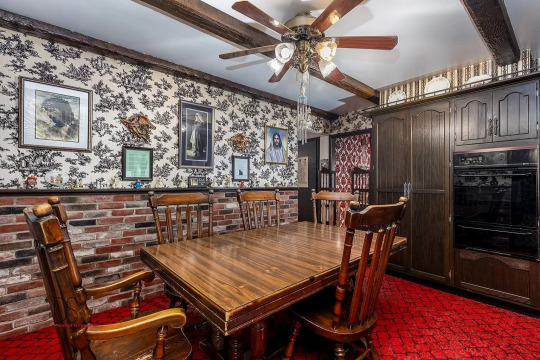
The 70s changed the color of wood- it became extremely dark, through the magic of Jacobean stain. The style included faux brick (which was not yet perfected and looked so faux), carpeted kitchens and ornate cabinetry with plate rails.

But the most distinctive feature was the kitchen lamp post. Even if I gutted this kitchen, I would keep that lamp post, b/c it's such a classic. I've even seen them built into the middle of kitchen tables. (Note the faux brick backsplash.)

Variations of this beloved bedroom set were in so many homes. Even my grandparents had one (and I inherited it). Plus portraits of the children on black velvet.

Wallpaper, fancy and flocked, even if it didn't match the style of the room.

There was a Toile Revival, too.

And, big, dark heavy furniture with fancy foo-foo ruffled fabric or fabric with eyelet borders. Notice the architectural detail of the bed on a platform with a heating vent for practicality.
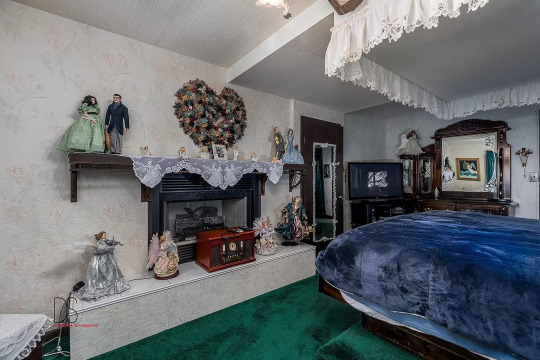
This fireplace was redone- they removed the mantle, in favor of a shelf, and framed in the hearth so they could display statuary.

It was also the advent of the wall-to-wall carpeted bathroom and tub draperies.

Note that red shag carpeting fades over time, and also pills, balls up, and irretrievably matts down. Check out what looks like a lighted nativity scene in the fireplace.

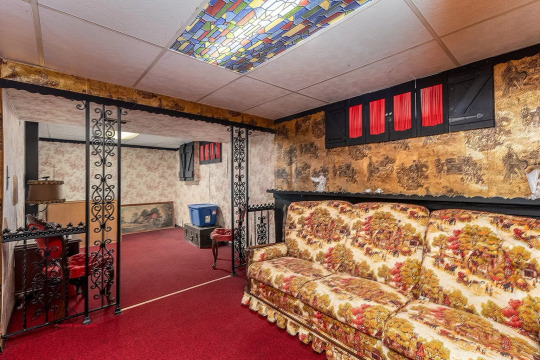
Ah, the manufactured "colonial" creations. Hanging metal fireplaces adorned with eagles and sofas with spindles, pleated skirts, and pastoral or historic Americana scenes. Wherever there was an opening, put up a fancy railing and/or panel.

What a bonus! A home beauty salon! Also, note the textured paneling and another popular feature- jigsaw cutout wood valances on everything from the kitchen cabinets to windows, to walls. (Also, there's a good example of how red carpet fades, in the corner.)


Some outer details (note the cutout valance even on the roof of the house).



I didn't expect a farm, but there're definitely barns and a silo on the property.
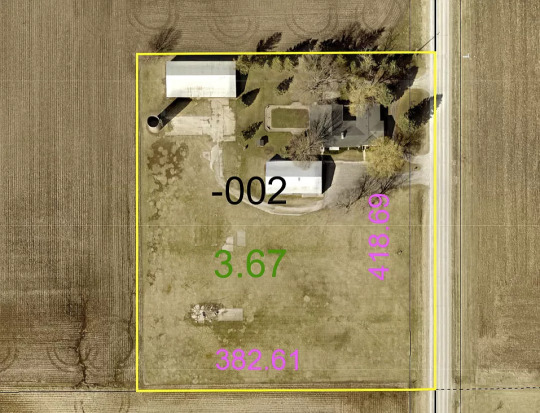
3.67 acres of land.
https://www.zillow.com/homedetails/2855-E-13th-Rd-Ottawa-IL-61350/115664434_zpid/
113 notes
·
View notes
Text
From my other post of diamond!Reader i was actually thinking if i should make a pearl! Reader as well now im flooded with ideas and i have school later at 6am and im still not asleep because of these thoughts not letting me sleep
You guys can decide whatever color the reader is-
Here are some of what i thought of:
Diamond!Reader who has a gem on their right hand, unlike the other diamonds she doesn't pick a planet to rule, instead she makes her own world using her powers, which is creation she can make anything she wishes but it has a limit the more she uses this power the more that she grows weak, she rules no planets and only helps the other diamonds rule their planets or find a unclaimed planet and tells it to the others, she is also considered the right hand person of white diamons
Diamond!Reader is close to pink diamond every time pink diamond is locked up on the tower she always visits her and a company her, the two were close Diamond!Reader sees pink as family and they barely talk to the other diamonds they're a quiet person around the others but she talks a lot around pink
Diamond!Reader who found the land of Khaenri'ah in which had no gods ruling over it they wanted and only humans at first they wanted to tell the others about this unclaimed land but the mortals in it peeked their interest as they witnessed them create and build these machines it amazes them that a mere mortal can make such a wonderful creations just by the things around them
Diamond!Reader decided to visit the nation to see in their own eyes the creation of these mortals, as they spends more and more time on the nation they felt an attachment to the people in it, and they had been hanging out with dain lately they felt like they were home and informed pink about this discovery and they're relationship with the mortals making pink shares about the new planet that was finally given to her to rule, earth
Diamond!Reader was well known in Khaenri'ah as they helped with some machines and inventions, some of it they created themself with help, making them quite popular as they help and participate in some inventions known to the nation, the people had viewed them as a very important person as without their help some of their inventions/creations weren't made thus they have build statues of them and they were well known by everyone
Diamond!Reader was also viewed as inspiring and admirable that some writers had decided to make a book about them, they're contribution to their country and to the way they help all of them to raise even more
Diamond!Reader who starts to neglect their job as a diamond and was in the mortals world to see and learn about the mortals, they have also met a blonde traveler from afar in which they have been trying to get to know as their friendship grow, so did their relationship with the diamonds fell as they haven't been going to their meetings nor helping the other diamond
Diamond!Reader was scolded by white diamond seeing her smile makes them shiver as she had no choice but to stop visiting Khaenri'ah, once they were informed about the rebel of one of pinks people and the troublesome things that it resulted they had gotten ready for the war, not before pink has told them about it, that rose and her is the same and she was only doing this so that she can live peacefully in earth, they agreed to keep this a secret
Diamond!Reader became busy with their responsibility as a diamond that she had forgotten about Khaenri'ah, and only remembered it when they were staring at the stars pondering thinking that it had been a long time since they last visited it they revisited the nation only to find it in a mess there were no more people and the joyous laughter of kids was no longer there and the warm smiles of the people and the welcoming aura is long gone
Diamond!Reader stared at the now fallen country and saw a familiar blonde haired traveler running to them as they asked what happened and claimed that the seven gods had destroyed it because it had no ruler, making them taken back from this information
Diamond!Reader felt heart broken as the joy and warm smiles of the people in Khaenri'ah have now turned to ashes, at least that what they thought as they decided to leave Khaenri'ah their heart yo heavy from the guilt that they couldn't protect Khaenri'ah and its people, they left Khaenri'ah and decided to leave to see more of teyvat
Okay so-, i have no idea what i just wrote, yes teyvat wasn't invented by diamond reader because i think i remembered that the diamonds would take a planet take every living land from it i think?- and mold the existing planet to whatever they please, diamond reader won't be doing that and instead only be views as a good because of the books and inventions they helped made, I'm sorry if some of it don't make sense, this is my first time writing so please forgive me if i made any mistakes or confusing things-
Its 1am rn, and i started writing this at 12am- so I'll prob head to sleep even though im supposed to wake up at 3am but whatever- I'll try to improve and try my best yo remember genshin and steven Universe lore because it has been a long time since the last time i have read them and i recently deleted genshin but i do remember the lore, so stay tuned! I'll try my best, slow updates too, it is a self aware, just wait for updates and I'll def explain it more for now ik brain dead and in need of sleep, see y'all!
Again this is my first time writing so forgive me if i make mistakes
#yandere genshin x reader#genshin impact x you#yandere x reader#yandere wanderer#yandere genshin#self aware genshin#genshin cult au#steven universe#diamonds
70 notes
·
View notes
Text
image description by @swosheep

ID 1: all images are screenshots of an Instagram post by j3wess, and are on a light green background with an even lighter green grid pattern. The first image is a title written in dark green text. It reads: "Evangelicals are the primary supporters of Israel in the US, not Jews". There is two Stars of David beside the words 'not Jews'. A wavy green line underlines everything.

ID 2: the second image is titled "why?". The title is separated from the body by a wavy white line. The body text reads: "the protestant fundamentalist theory of dispensationalism views history as a series of seven events. so far, six have already occurred." An ordered list, in white text, reads: "1 the era of innocence: before adam's fall. 2 the era of conscience: from adam to noah. 3 the era of government: from noah to abraham. 4 the era of patriarchy: from abraham to moses. 5 the era of mosaic law: from moses to jesus. 6 the era of grace: from jesus to today." The green body text continues: "and the seventh and final dispensation will be millennium, an earthly paradise. and millennium requires gods chosen people, the jews, to all be living together in israel. it is there, supposedly, that they will rebuild the temple. then, as described in the book of revelation, armageddon will take place and in the process 2/3 of jews will die and the other 1/3 will accept jesus as the messiah. jesus will then return to earth and will institute a millennium, beginning a thousand year reign over earth as king."
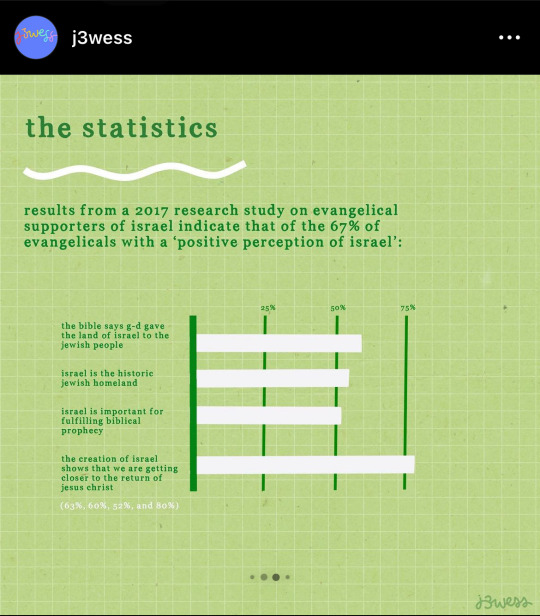
ID 3: the third image is titled "the statistics". a white wavy line separates the title from the body text. The body text reads: "results from a 2017 research study on evangelical supporters of israel indicate that of the 67% of evangelicals with a 'positive perception of israel':" Below, there is a bar graph. The first bar is captioned: "the bible says g-d gave the land of israel to the jewish people". The bar is at 63 percent. THe second bar is captioned: "israel is the historic jewish homeland". The bar is at 60 percent. The third bar is captioned: "israel is important for fulfilling biblical prophecy". The bar is at 52 percent. The fourth bar is captioned: "the creation of israel shows that we are getting closer to the return of jesus christ". The bar is at 80 percent.

ID 4: The fourth image is titled "what's scary about this?" A white wavy line separates the title from the body text. The body text reads: "a majority of christian support for zionism and israel is because it will supposedly trigger the return of christ. in order for this to happen requires for a) all diasporic jews to return to the land, therefore displacing palestinians and b) jews to be either proselytized and abandon their own religion for christ or die." Below this text, a second title reads: "what's even scarier?". Body text reads: "despite israel claiming to represent and protect all jews, it prioritizes the support of evangelicals."
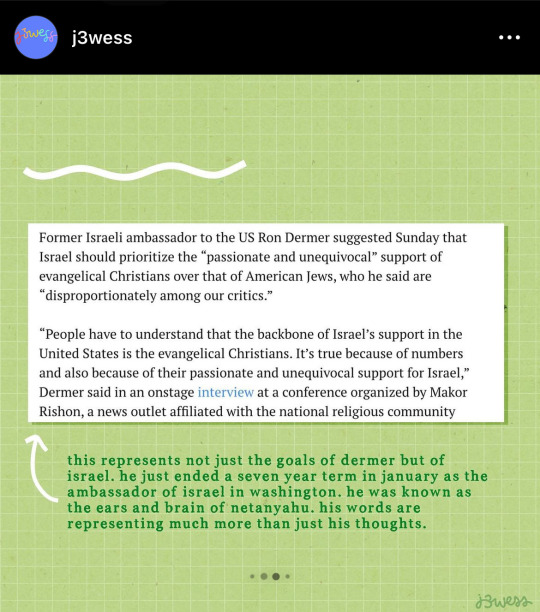
ID 5: the fifth image is untitled. It has a screenshot from an article which reads: "Former Israeli ambassador to the US Ron Dermer suggested Sunday that Israel should prioritize the 'passionate and unequivocal' support of evangelical Christians over that of American Jews, who he said are 'disproportionately among our critics.' 'People have to understand that the backbone of Israel's support in the United States is the evangelical Christians. It's true because of numbers and also because of their passionate and unequivocal support for Israel,' Dermer said in an onstage interview at a conference organized by Makor Rishon, a news outlet affiliated with the national religious community". Green text below it says: "this represents not just the goals of dermer but of israel. he just ended a seven year term in january as the ambassador of israel in washington. he was known as the ears and brain of netanyahu. his words are representing much more than just his thoughts." There is a white arrow pointing from the green text up to the article screenshot.

ID 6: the sixth image is titled "sources". There is a wavy white line separating the title from the body text. The body text consists of four sources, which are as follows: "times of israel: dermer suggests israel should prioritize support of evangelicals over us jews. lifeway research: evangelical attitudes toward israel research study. city journal: why don't jews like the christians who like them? america magazine: understanding the evangelical obsession with israel."
working links include:
#resources#palestine#jewish#israel#united states#evangelicals#instagram#reaux speaks#colonialism#genocide#occupation#religion#free palestine
105 notes
·
View notes
Text
Amore Mio [Secret Trope]
Pairing: Frank Castle x Female Reader
Trope de Sept Masterlist | Main Masterlist

Secret situation 1. Character A is keeping a secret from Character B, until it comes out in a dramatic moment. "Frank has been keeping something from you."
Warnings: No use of Y/N. Female Reader. FLUFF. Based on a wonderful request from @xxdrixx . I hope my Italian is not shit, but I know just a little bit from singing opera and kinda went off what I know from that.
WC: 734
*I never give permission for my fics, manips, or any other original creation I post on this site to be copied, posted elsewhere, translated, or fed into any AI program. The only platform I currently post anything on is Tumblr. Thanks!*
Frank’s phone went flying across the room, landing with a plonk in the armchair.
You looked at him curiously, having just come back from making popcorn in the kitchen.
“What was– ?” you asked
“Picture of a snake. Fuckin scared me.” Frank responded
You rolled your eyes at the thought of the Big Bad Punisher getting spooked at a photo of a snake popping up on whatever app he was on, but you sat beside him and started the movie, the incident soon leaving your mind.
But several more times over the next few months, situations like this would happen. You’d walk into the room and Frank would suddenly get nervous and find an excuse to close his phone quickly.
If it were any other man, you might find it suspicious, but Frank was too loyal and honest for you to ever suspect anything nefarious.
Then came date night. Frank had taken you to an unusually nice restaurant, having even put on a pair of pants that weren’t jeans just to spoil you with a romantic evening.
Except his mind seemed a million miles away and he kept picking up his phone, reading something while muttering to himself, then putting it down suddenly when he noticed you staring.
You were about to ask just what the hell was up, when the waitress came over to take your order.
“Hi, my name is Francesca. I’ll be taking care of you tonight. Can I get you guys started with some drinks?”
Your face lit up hearing her speak, recognizing a familiar accent in her voice.
“Sei Italiana?”
“SÌ!” she responded
You talked for a few minutes, reminiscing in Italian about where you were from. Frank watched the two of you, smile on his face as he knew how much you loved speaking in your first language and meeting people from your home.
The waitress was so excited to connect with you, she even brought you and Frank free dessert at the end of the meal, delicious creme brulee the perfect way to end the evening.
“Wanna take the scenic route home?” he asked, offering his hand out to you
You nodded with a smile, happy to have a date night with Frank that didn’t involve him rushing off halfway through to go deal with ‘business’.
There was a chill in the air as you walked hand in hand along the pier of Hudson River Park.
Frank’s jacket was draped across your shoulders, ever the gentleman keeping you warm when you prioritized your outfit over dressing for comfort and the weather.
You stopped walking after a while, leaning side by side on a railing and watching the lights of New Jersey sparkle across the water. Frank’s hand was splayed across your lower back, a quiet gesture of affection and protection.
After a few minutes basking in the comfortable silence of each other's presence, Frank finally spoke.
“Amore mio. My love.” he whispered in your ear
Your spine went rigid and goosebumps crawled along your skin. You’d never heard Frank speak Italian before.
“Hai cambiato la mia vita. You have changed my life.” he continued, voice trembling from nerves “Non riesco a immaginare un futuro senza di te. I cannot imagine a future without you.”
Was this really happening? Had Frank learned your native tongue just to use it for the most romantic proposal ever?
His familiar touch disappeared from your side as he knelt down on one knee beside you, pulling a velvet box from his pocket.
“Vuoi sposarmi? Will you marry me?”
You could feel the tears coming on as his big brown eyes stared up at you, waiting for your answer.
“SÌ” you responded with a shaky voice, too overcome with emotion to manage much else.
A grin like you’d never seen spread across his face as rose to his feet and kissed you deeply.
After he slid the ring on your finger, you knew you had to ask.
“How long have you been learning Italian, mio caro?”
“Bout six months. Wanted to get it good enough to do this. Maybe we can do our vows in Italian too?” Frank responded sheepishly, pulling out his phone and tapping the icon with the green owl to show you just how much he’d progressed on his own.
Now you understood what he had been hiding on his phone from you.
“Perfetto. Perfect.” you said, kissing him once more
104 notes
·
View notes
Note
I know it wasn’t the point of your recent Chosen post, but I’m curious what you identified as signs of power-creep 👀
I should clarify, when I said "signs" of power creep, I really mean like, the barest hints that are making me nervous. Episode V does a great job of juxtaposing the earth-shaking attacks of Chosen and Dark to give them a sense of scale, by showing how Second and the Color Gang are constantly blown away by the things these two demigods can do (and on that note, Chosen fans have it REALLY good compared to Color Gang fans when it comes to having your favorite characters meaningfully contribute to fights in the main series. It's like Piccolo fans vs. Yamcha fans). But there's still a few parts that irk me.
Chosen is constantly landing laser eyes on Dark throughout their fight, and Dark is always surviving because he blocks with his arms. Then he puts on the wristbands, and his first big demonstration of how much more powerful they make him is... tanking Chosen's laser eyes with his arms. I get that the difference is "being forced to defend himself" vs. "gliding down the attack to interrupt it with one of his own", but it still just felt weird. Part of it was probably the stylistic choice to change the laser eyes from causing massive explosions in 2 and 3 to actually just cutting and burning things in 5 and 6, which I think IS a good change that makes the laser eyes more distinct from his pyrokinesis, but it also means that they just don't feel like they have much meaningful impact anymore. The last time they did was when he sheared off one of ViraBot's limbs with them.
That's kind of the main thing - a lack of impact with a lot of Chosen's attacks. The Mercs are implied to either be tanky enough to survive his attacks or (in the case of Pivot) have some defensive options, but there's that one moment in particular where Chosen gets fired up and launches all three of the other Mercs off of him with a burst of fire... and that doesn't seem to hurt them at all. If you don't give these superpowers the impact they need on a regular basis to establish how destructive they are, it starts to feel like they're pointless; like he'd basically be doing the exact same thing by just punching and kicking with his super strength.
I saw someone claim that Chosen lost the fight against the Mercs because he's going through a moral crisis and wasn't trying to kill them, and I have to wonder if that person watched the same episode I did - if Chosen wasn't trying to kill the Mercs before he started fleeing, why the hell would he go and grab Second Coming explicitly because he remembers how ungodly powerful she was with her powers awakened? It feels like a poor excuse for Chosen just feeling too underpowered lately.
Sidenote: The Box is not an example of this. The Box is genius, displaying that Victim is so underpowered compared to Alan's other creations that he needs to be buffed ten times over and have his opponent reduced to about 1/10th of their own strength, and Chosen still gets the upper hand a few times because he's A) just that strong and B) far more experienced fighting people his own level than Victim is. Seeing how his pyrokinesis completely renders his clones helpless and incinerates them within seconds did a lot of good work towards re-establishing how dangerous Chosen is, not to mention how his ice-defense trick demonstrates how he's not the dumb brute a lot of the fandom thinks he is.
TL;DR: It's somewhat a symptom of Chosen losing so many fights, which really isn't even that valid of a criticism when we're only two parts in to the sixth installment. What bothers me the most is that he keeps fighting people who can seemingly just shrug off his powers, which makes his powers feel pointless.
#Alan Becker#Animator vs. Animation#The Chosen One#AvA TCO#You asked me about something we both knew wasn't even the main point of my post#I replied with (counts) six paragraphs#I'm so sorry
41 notes
·
View notes